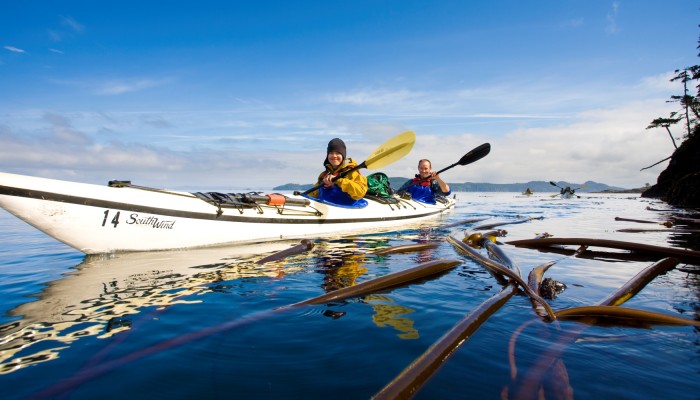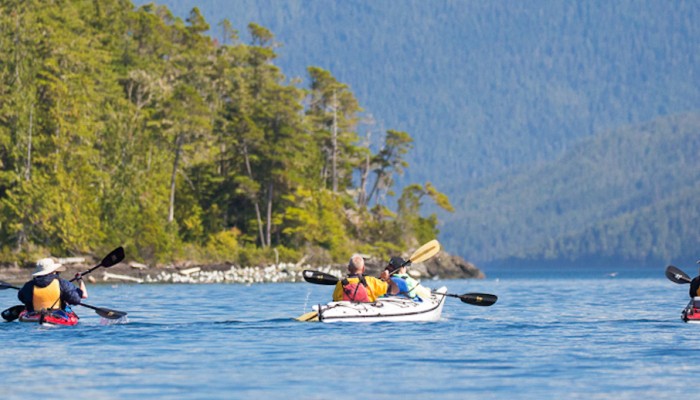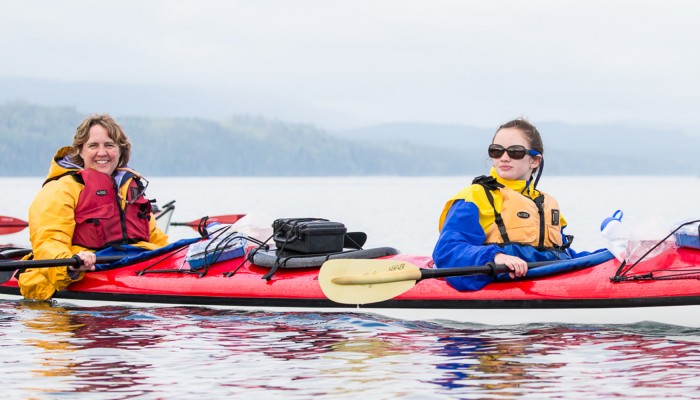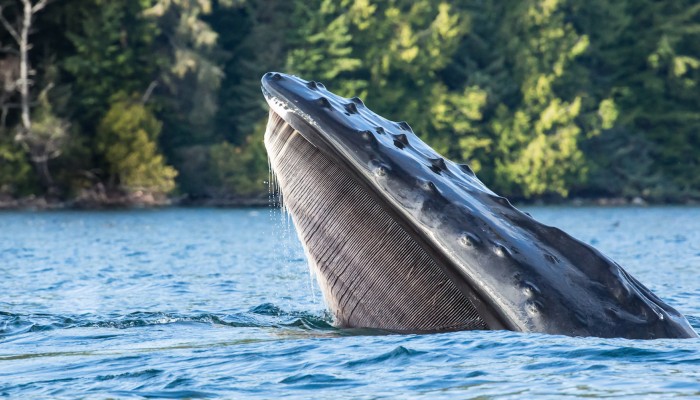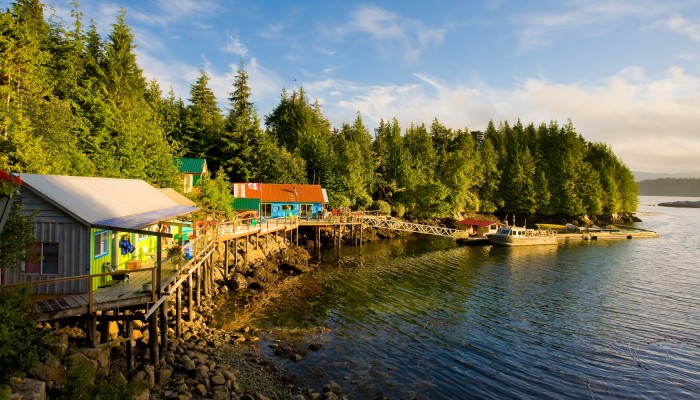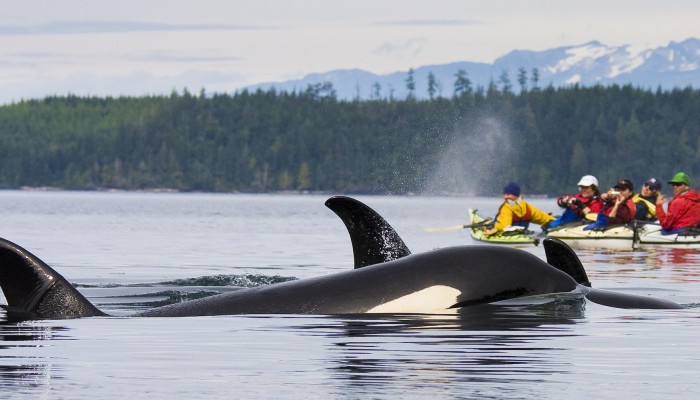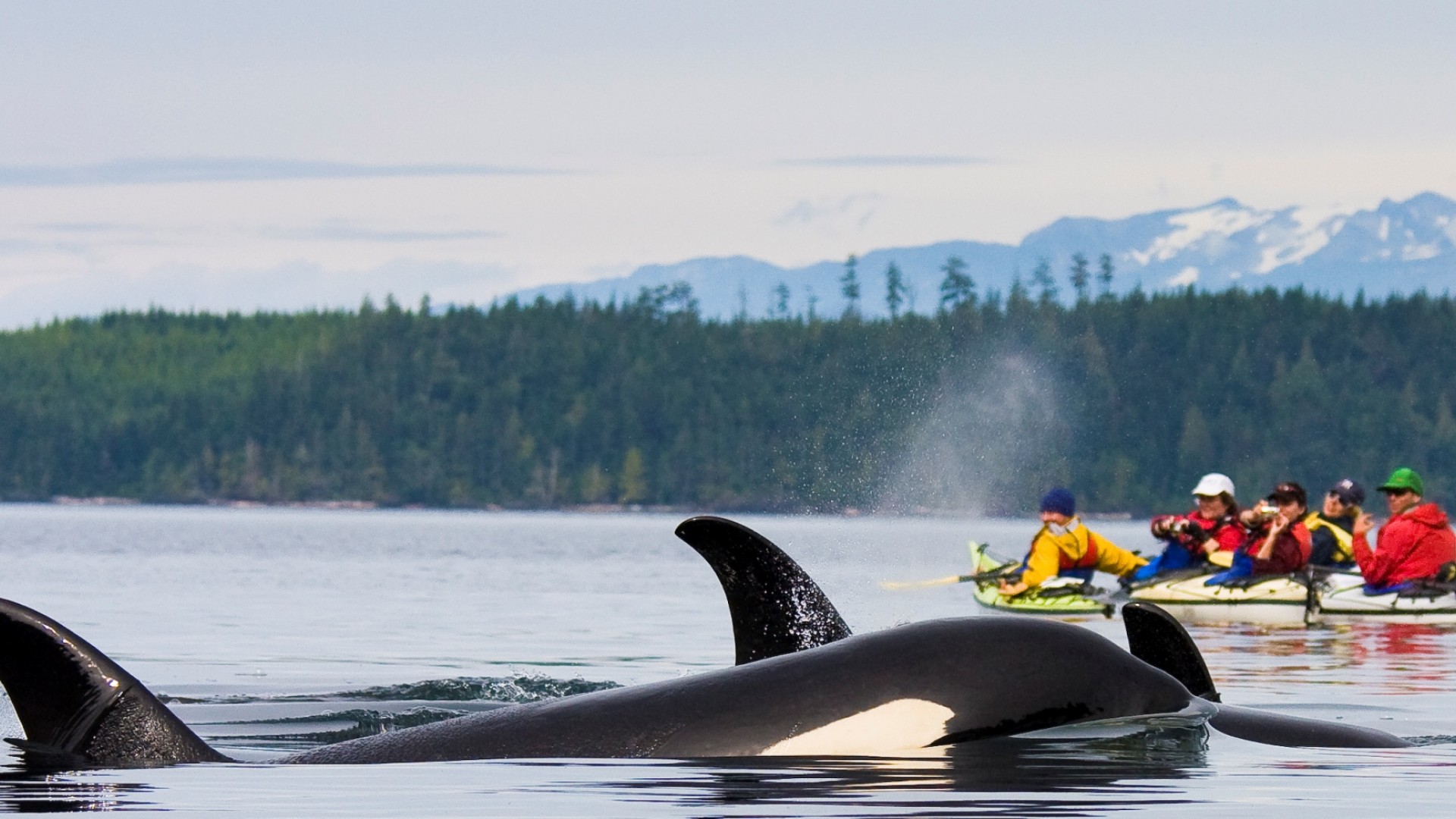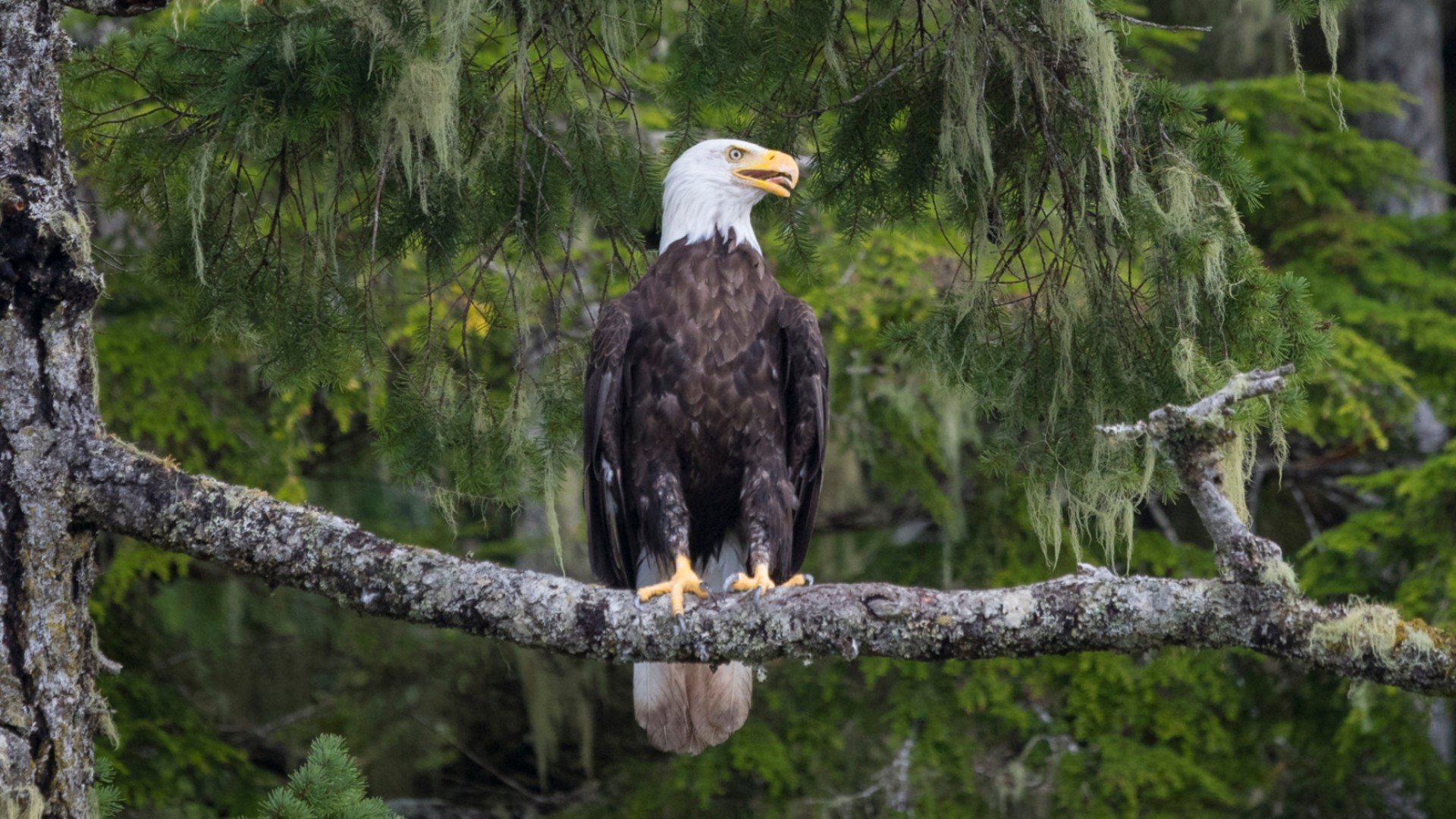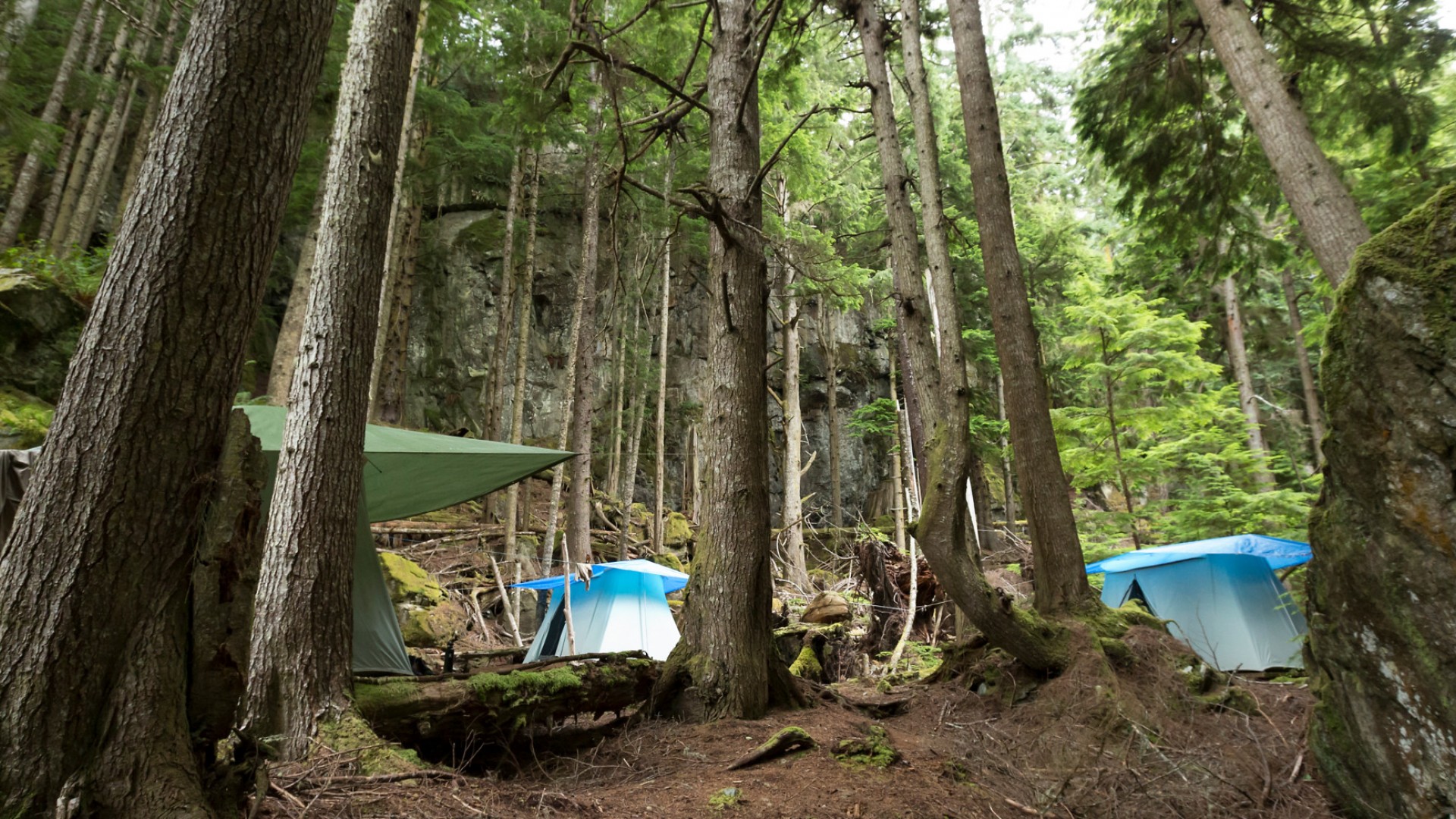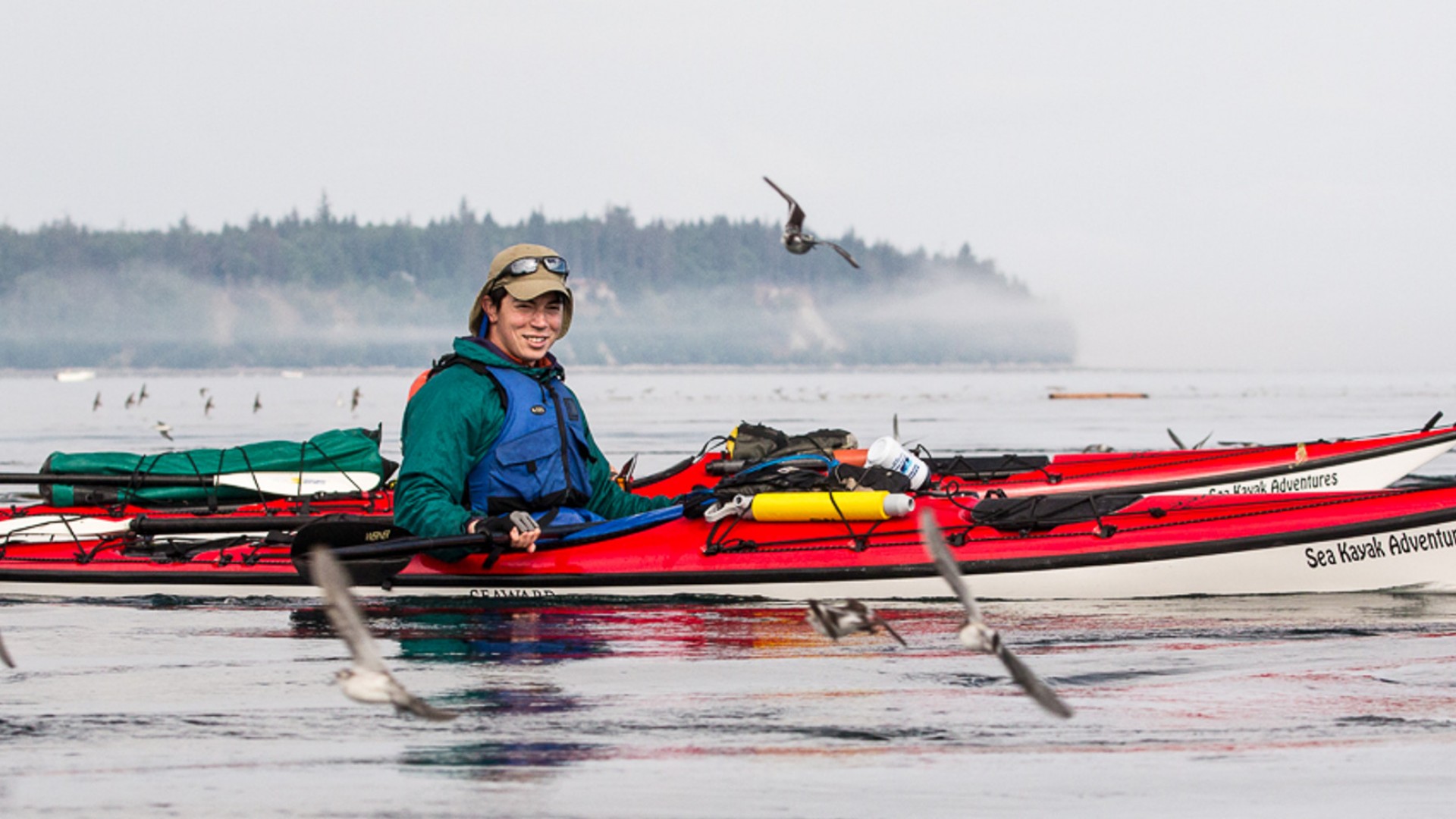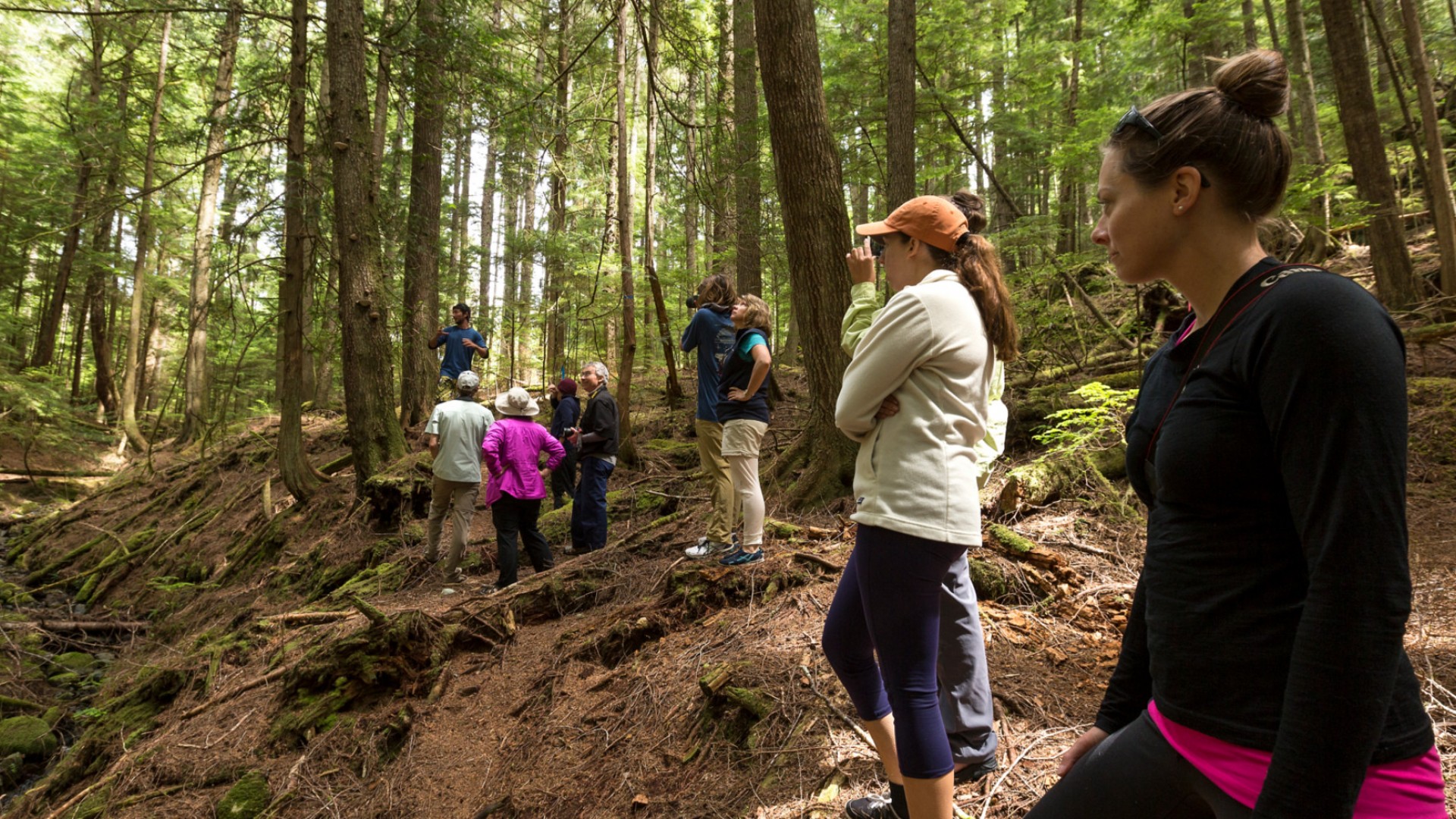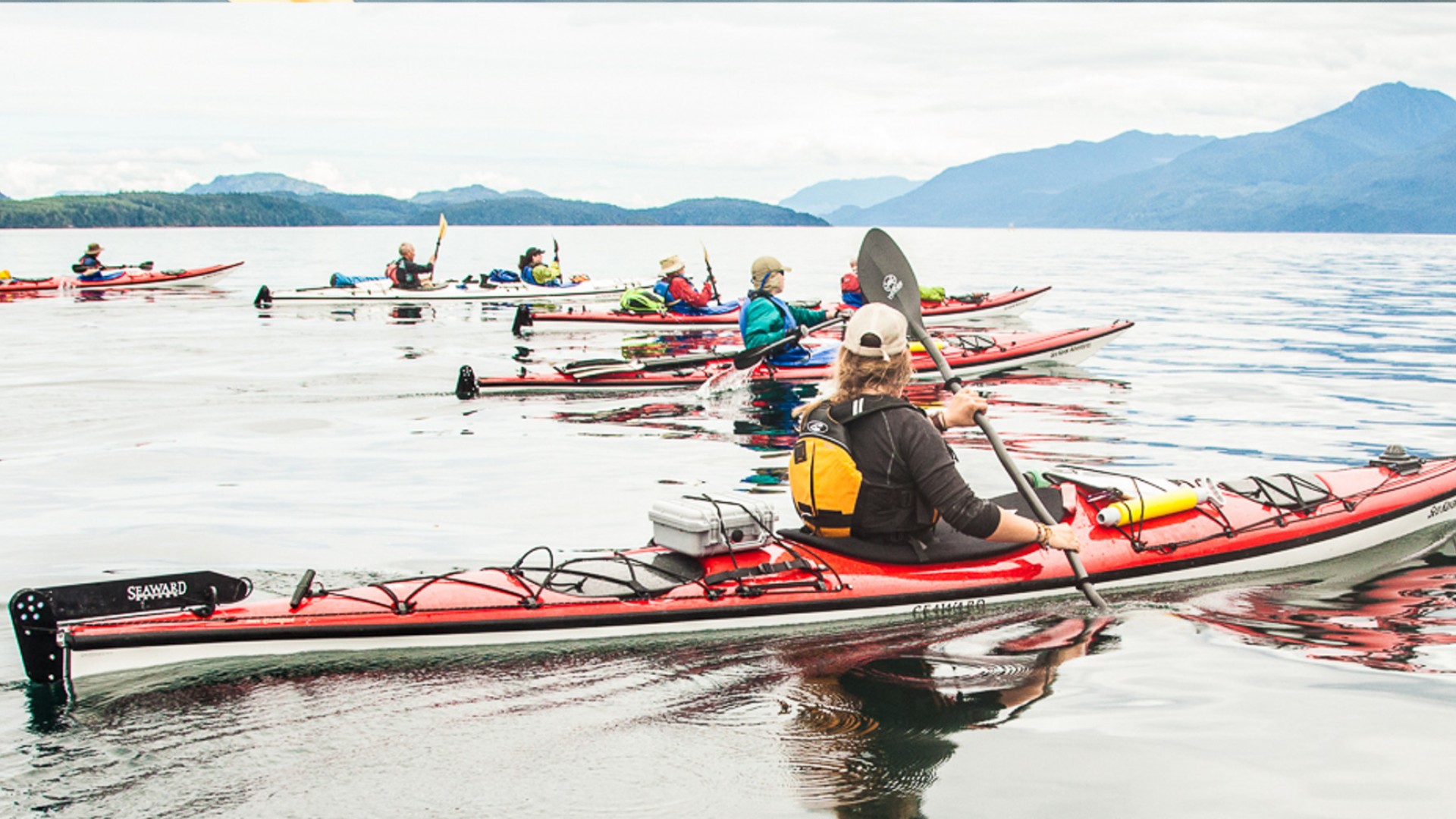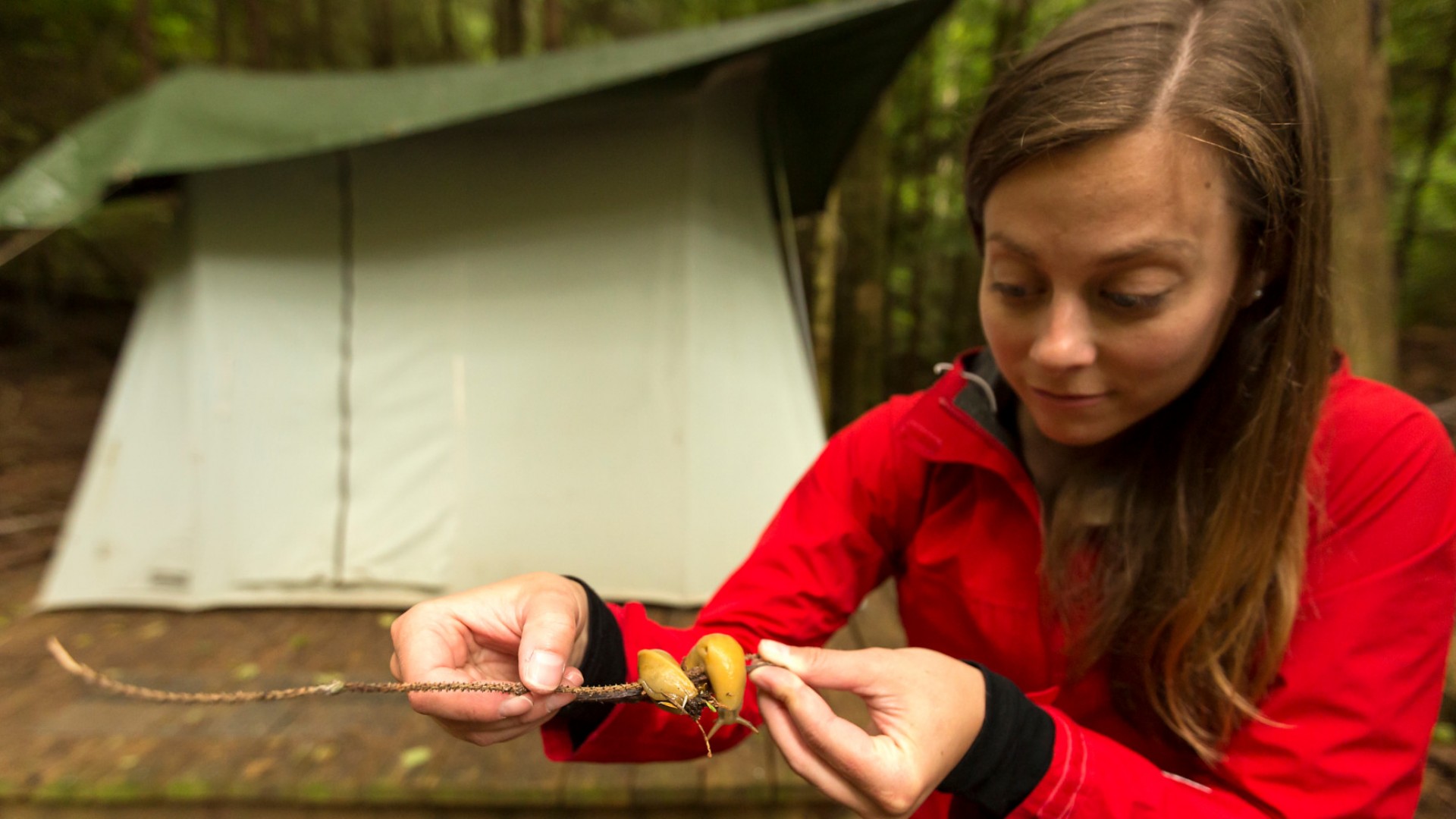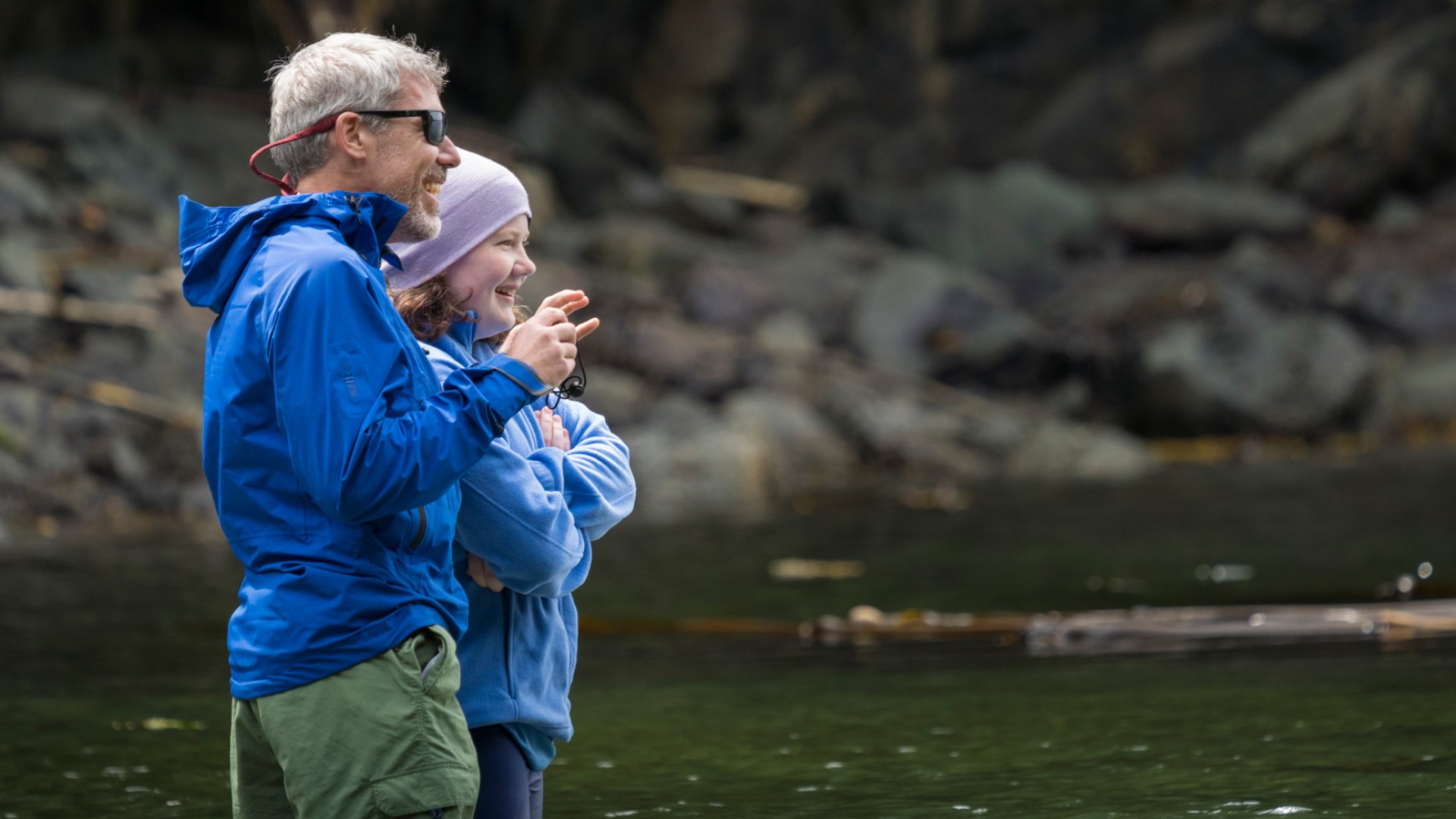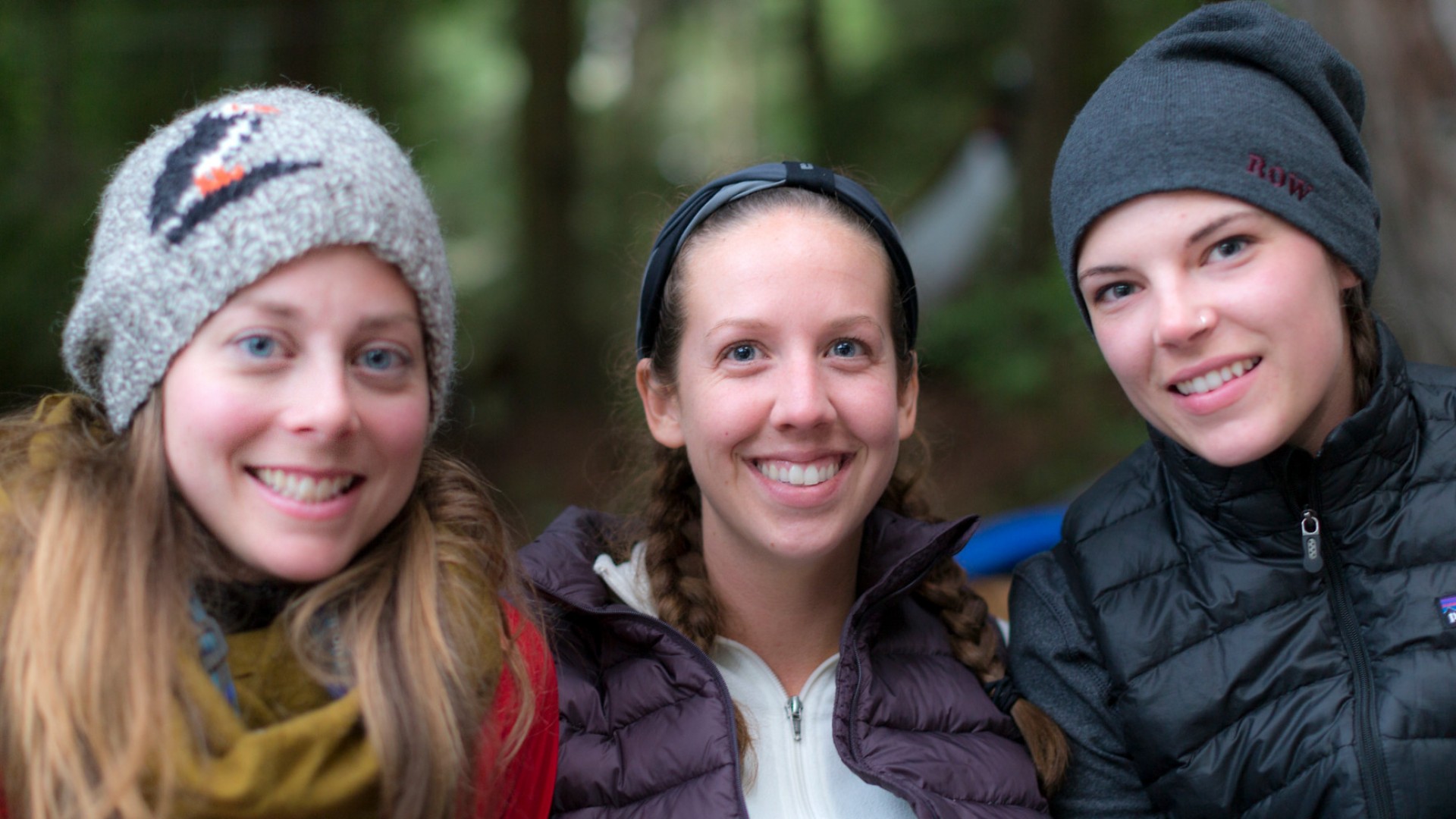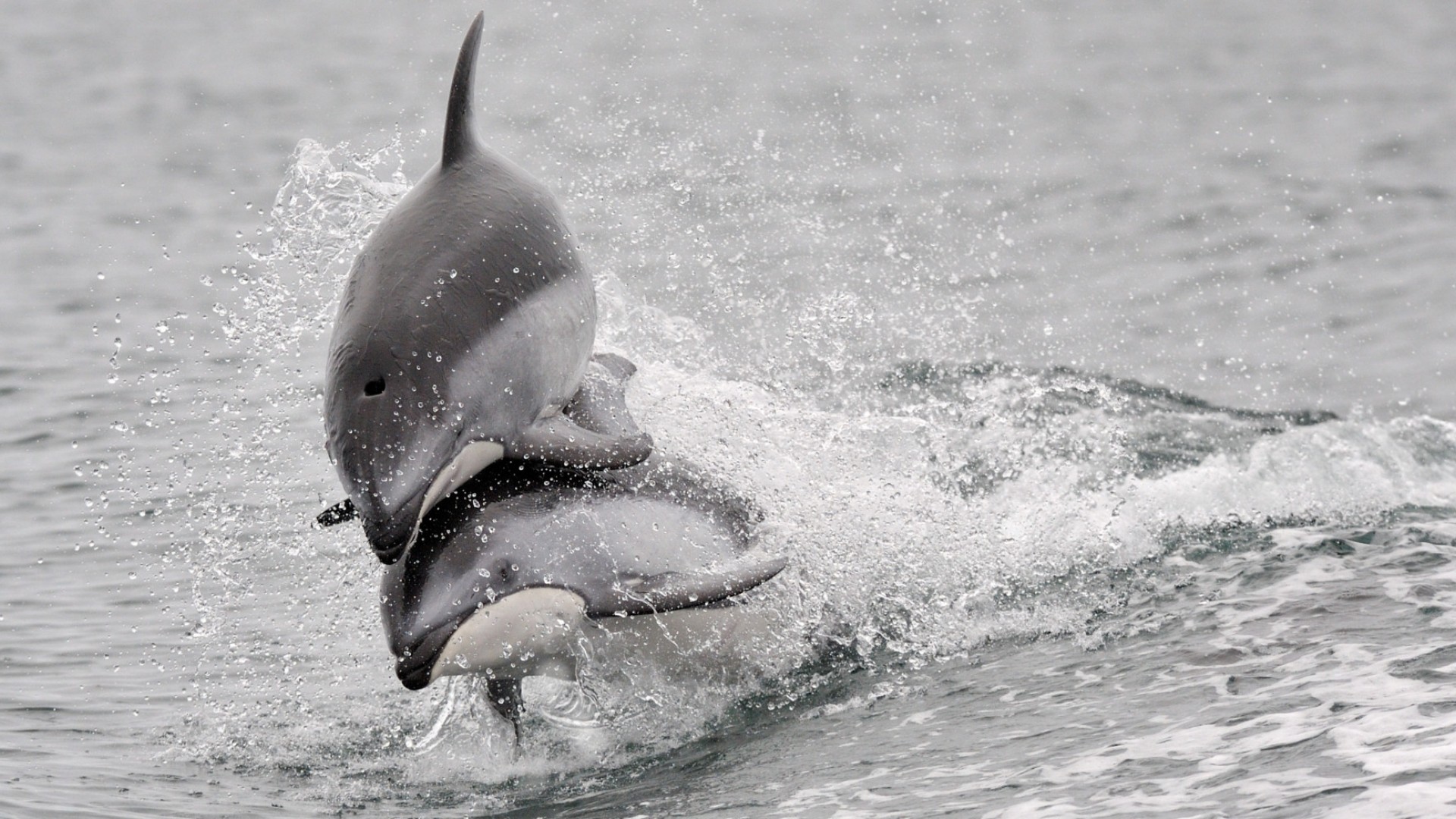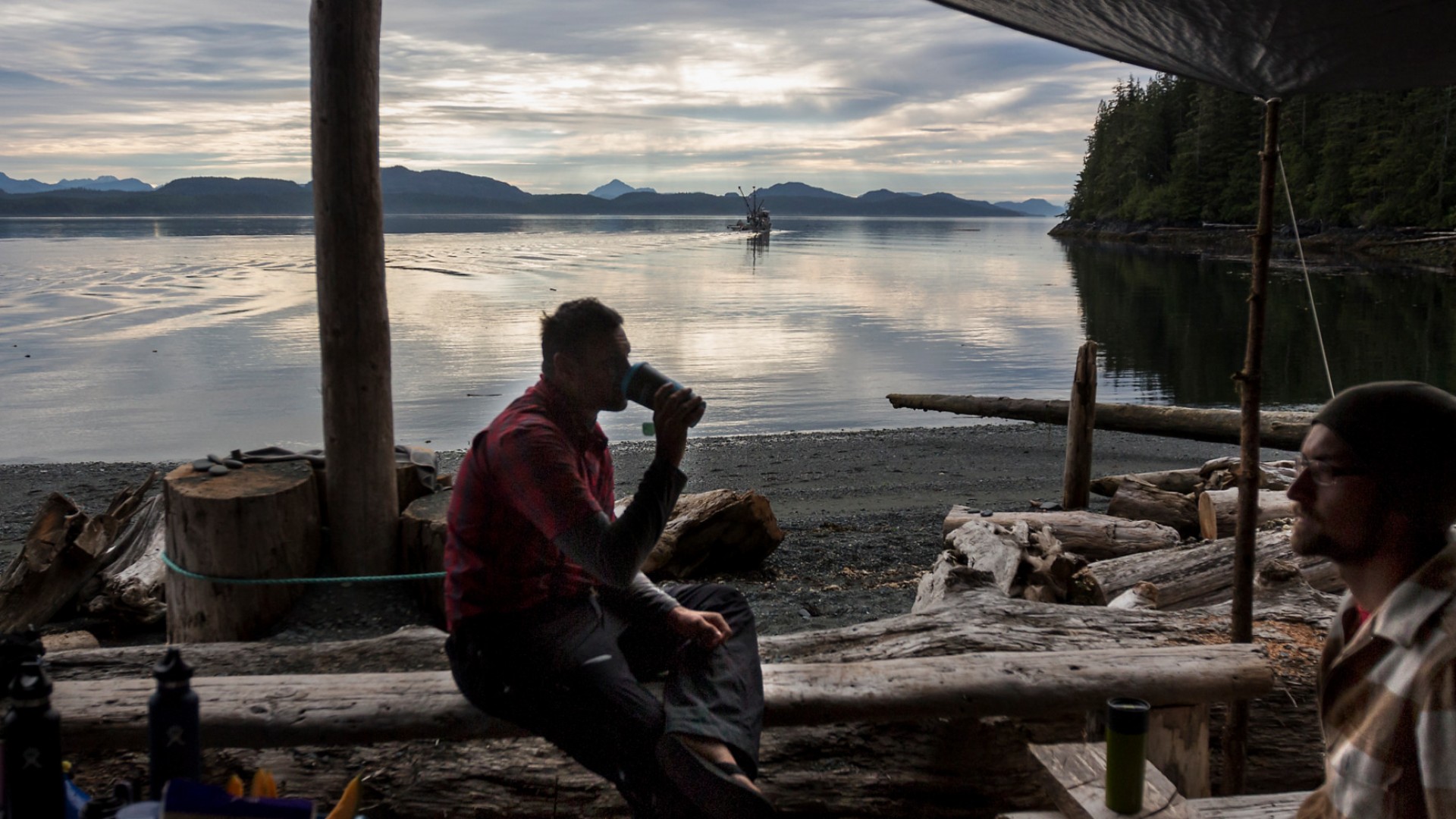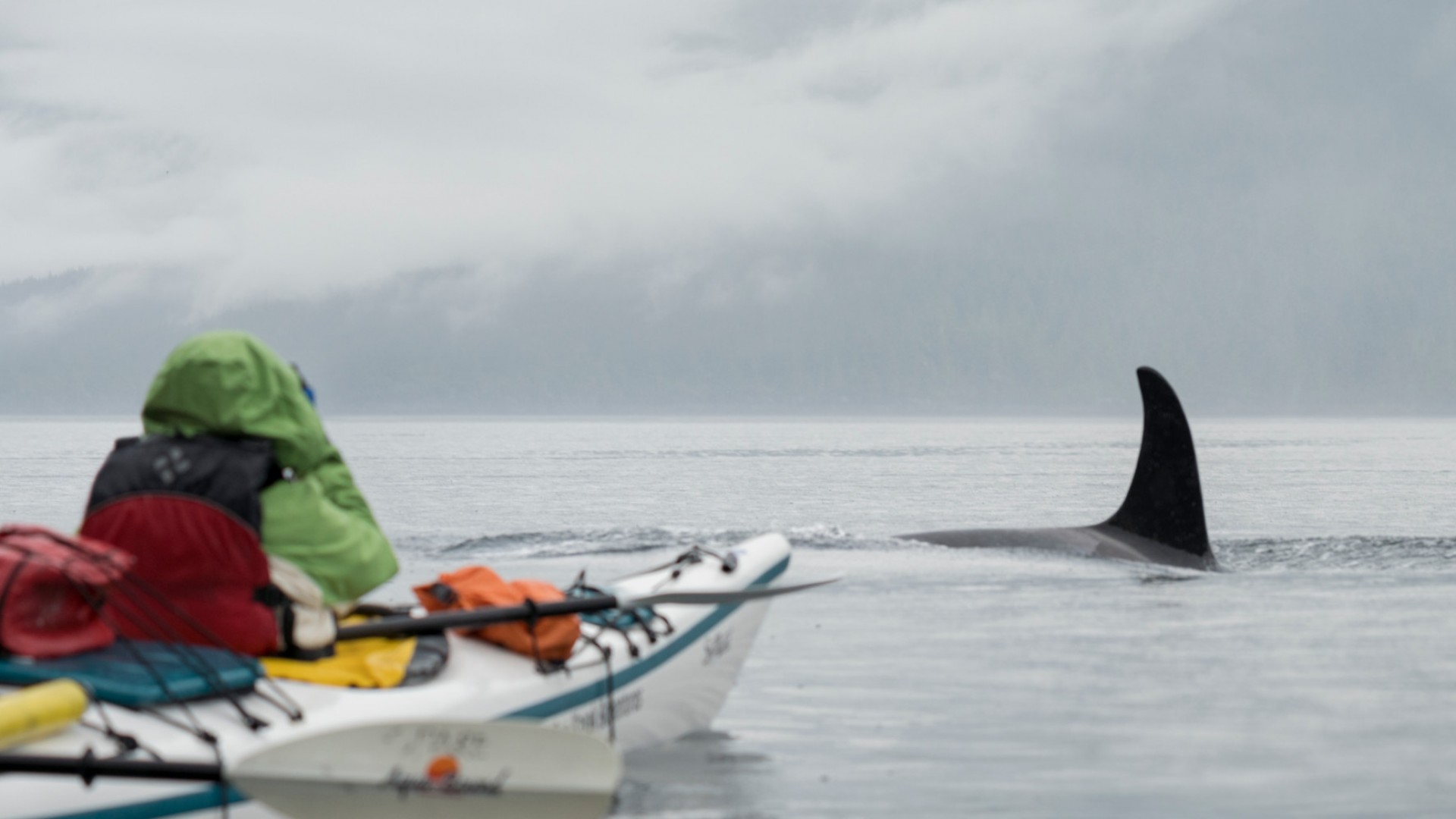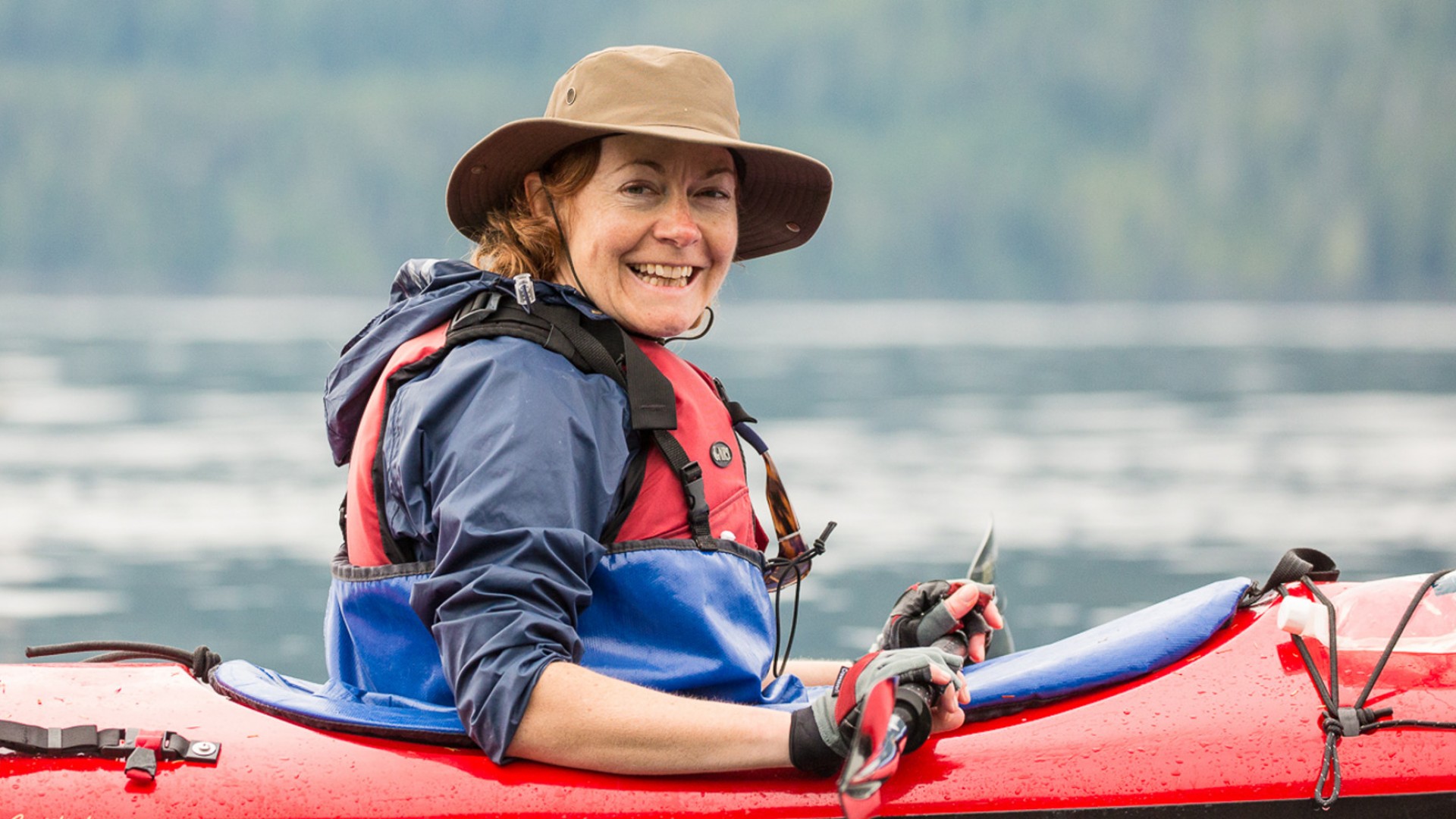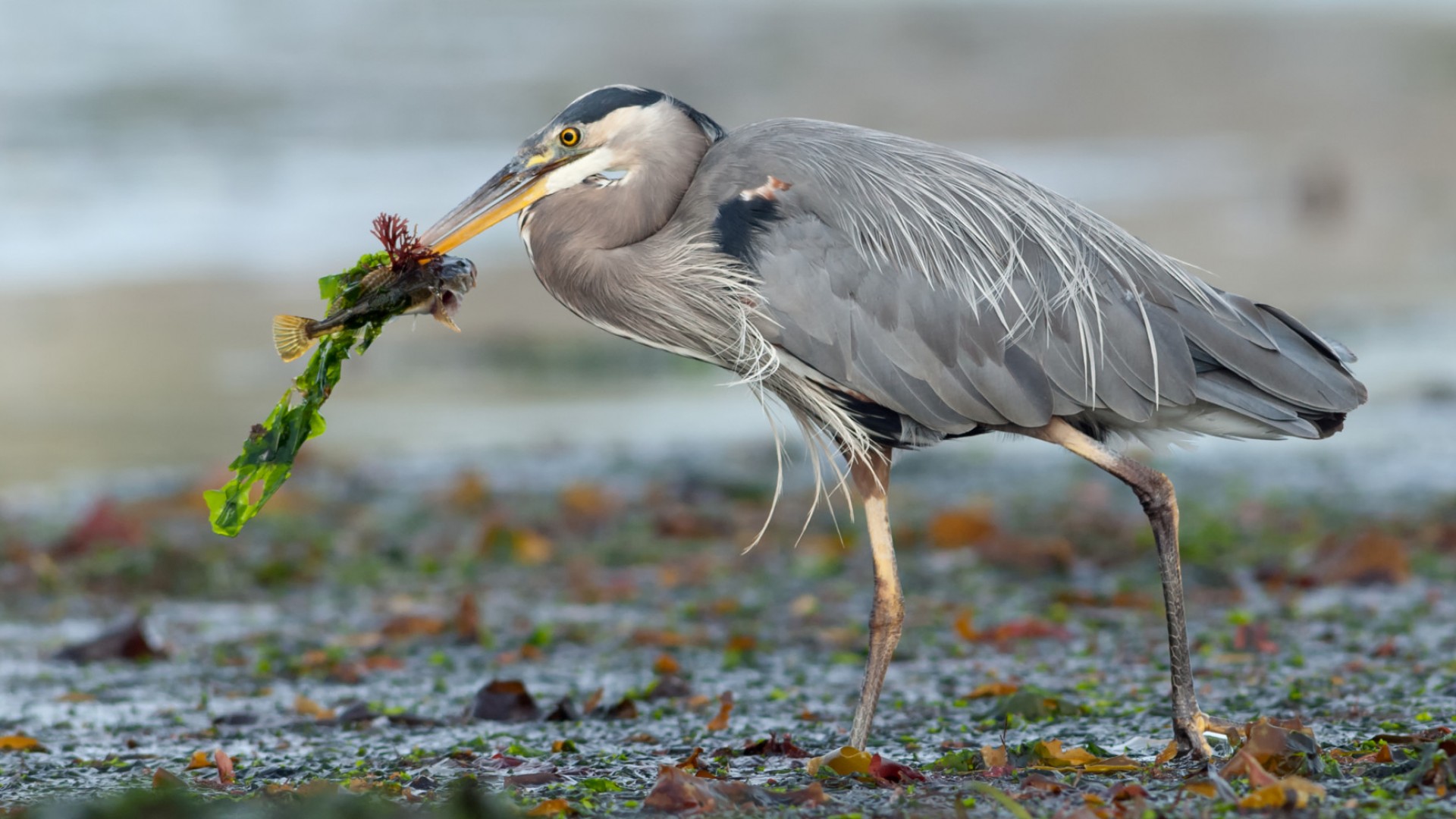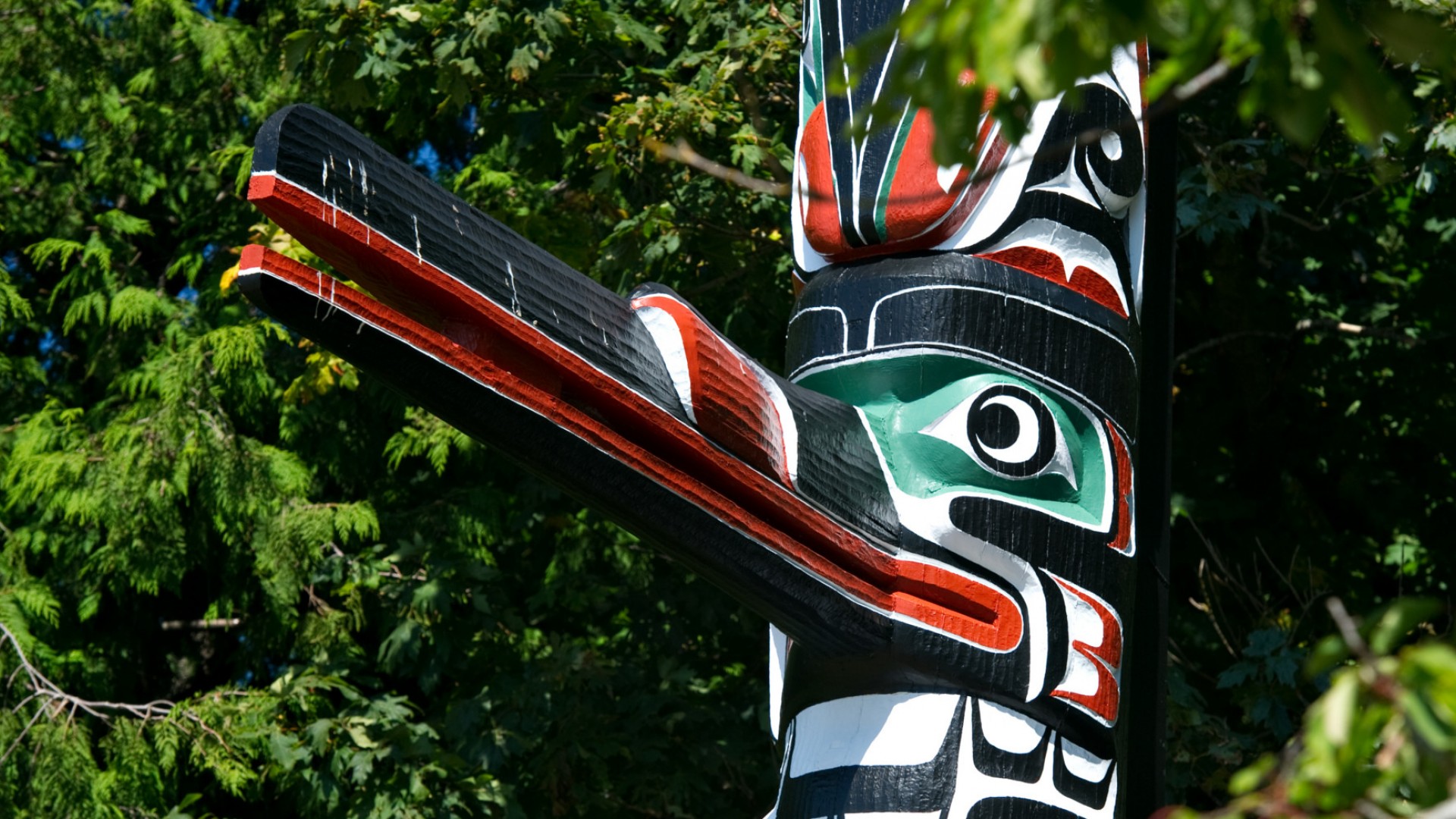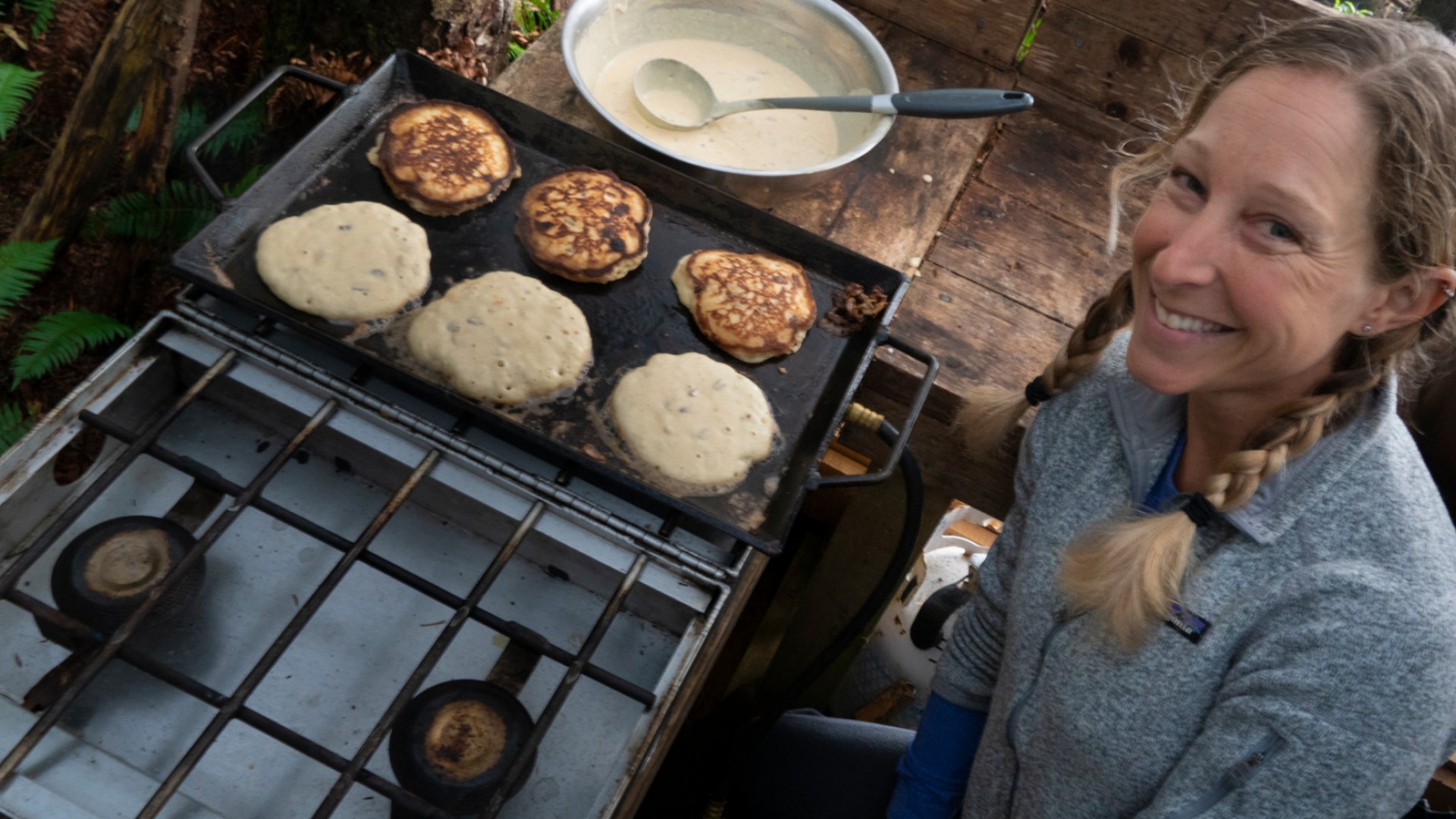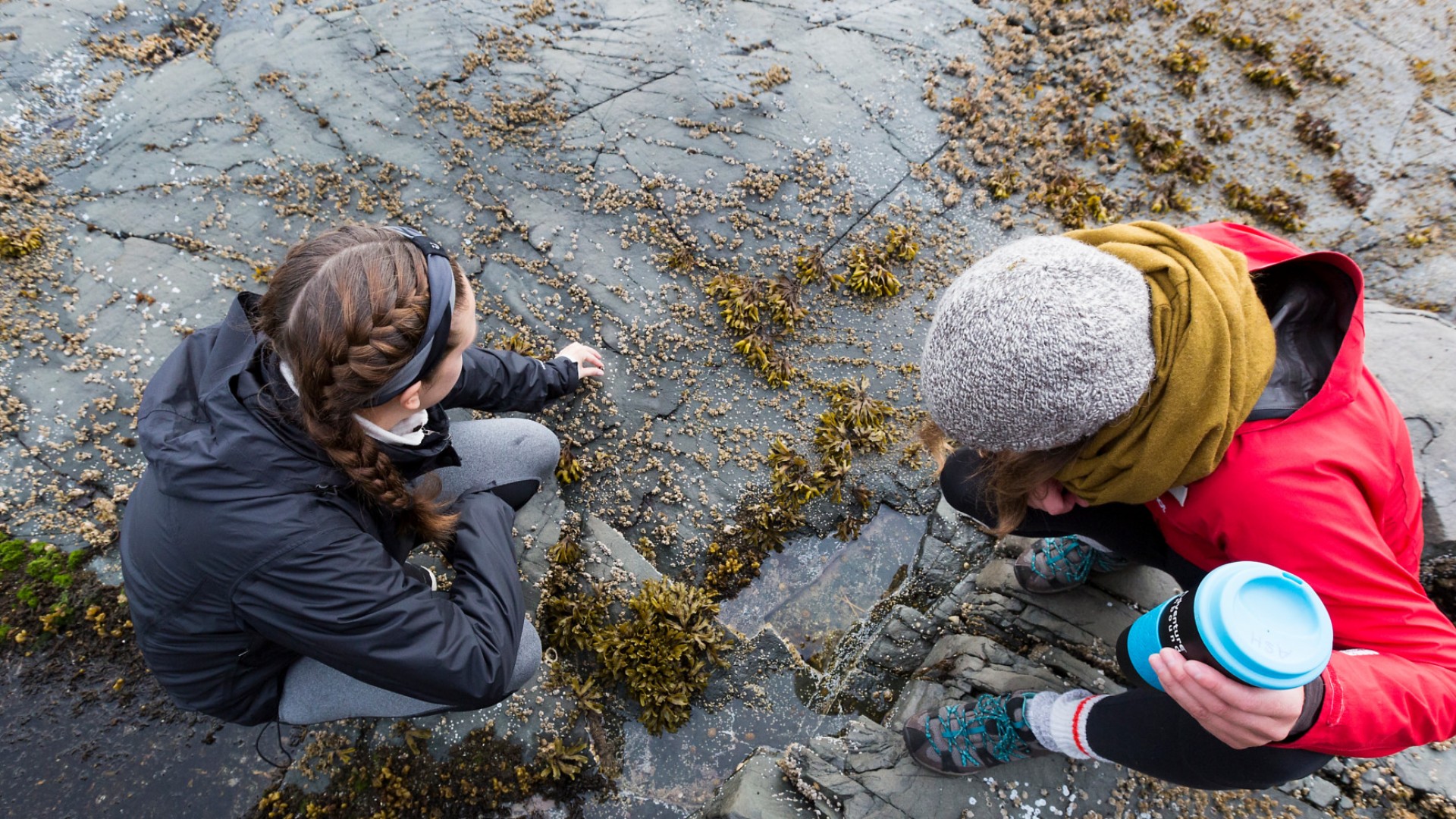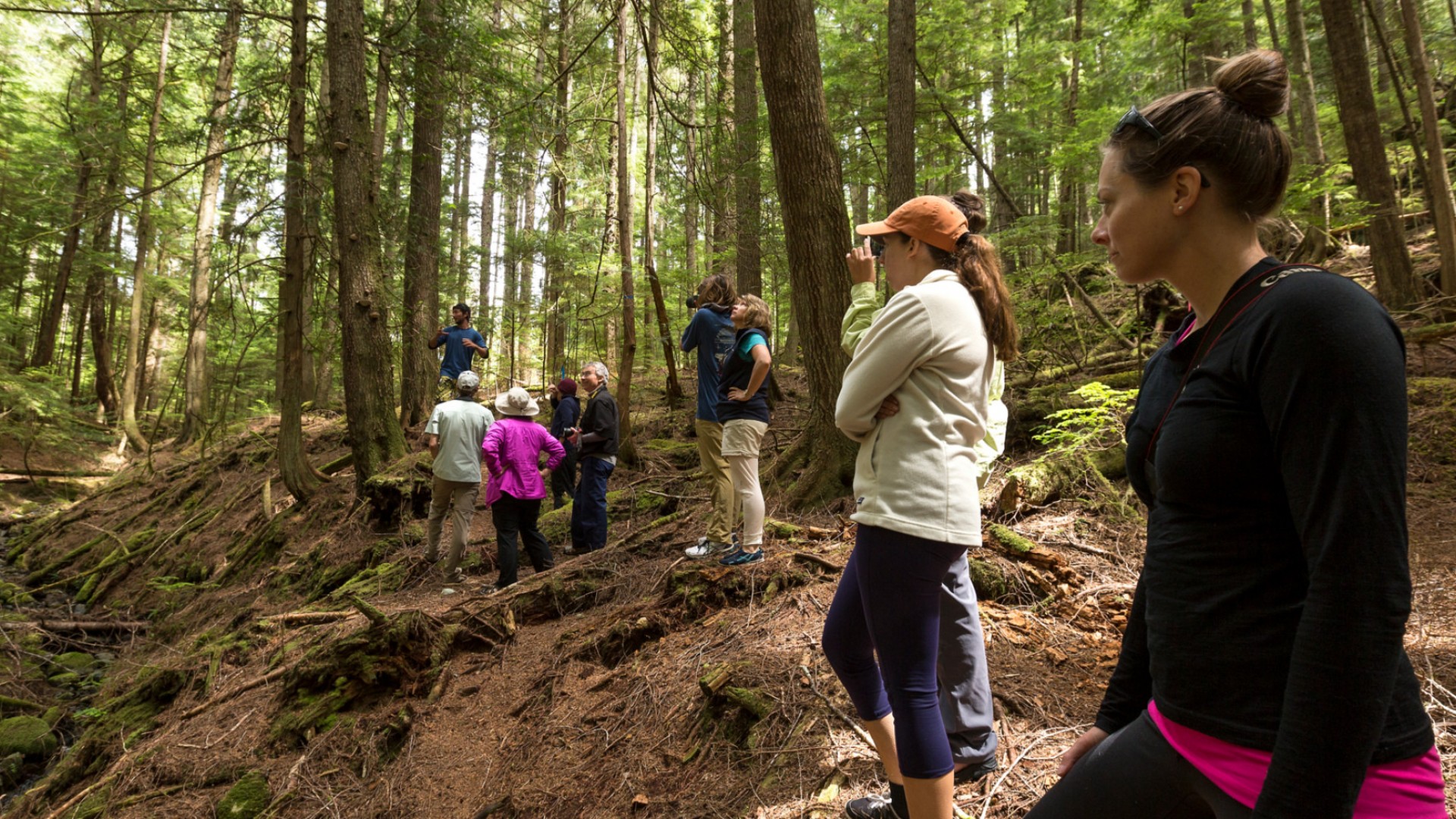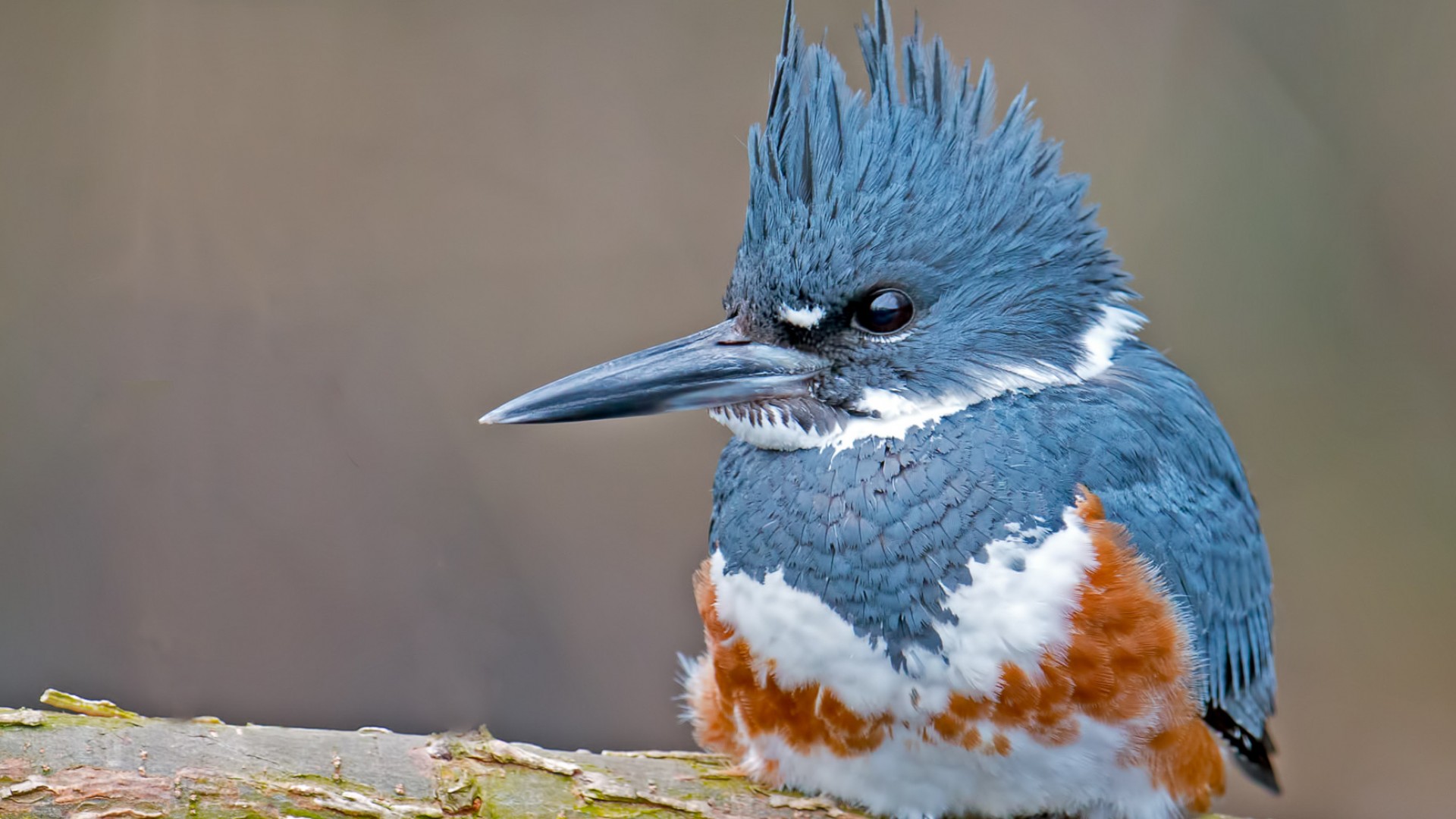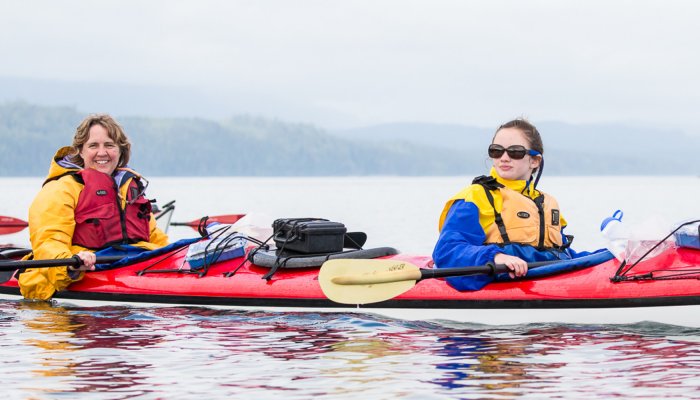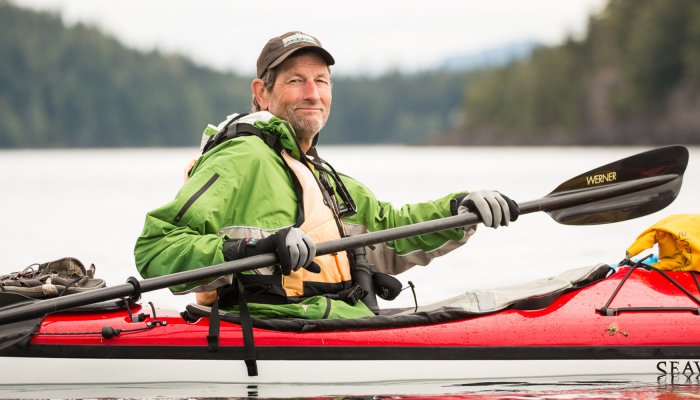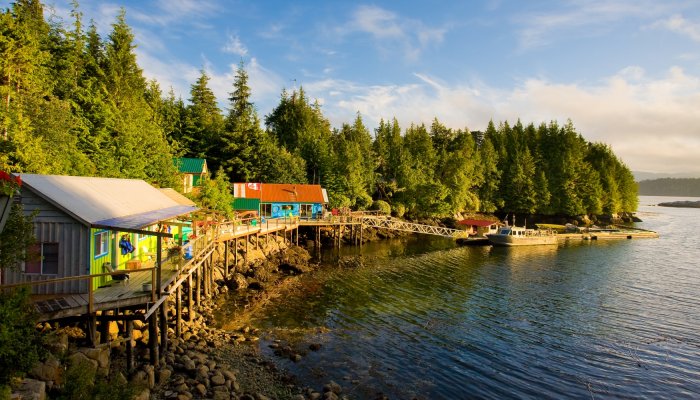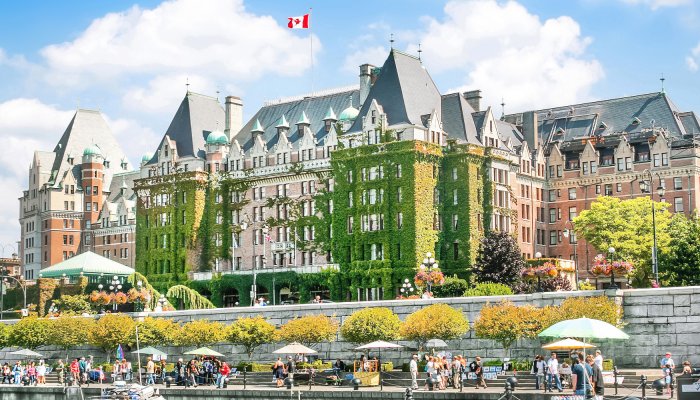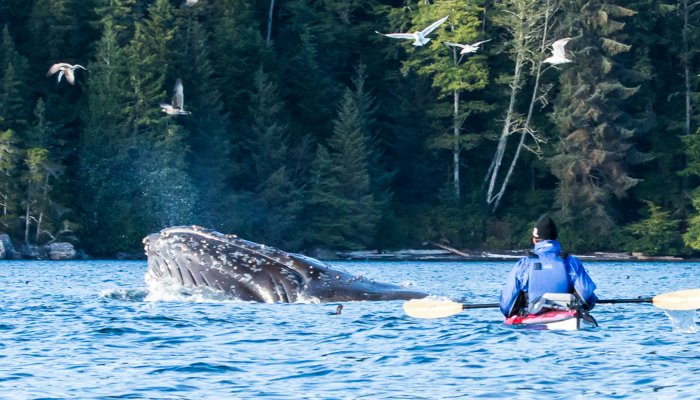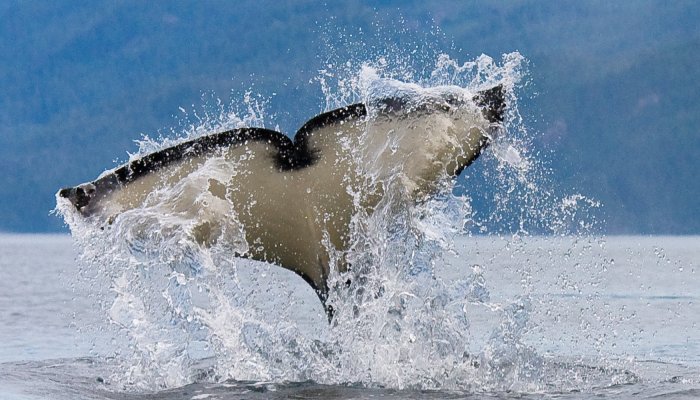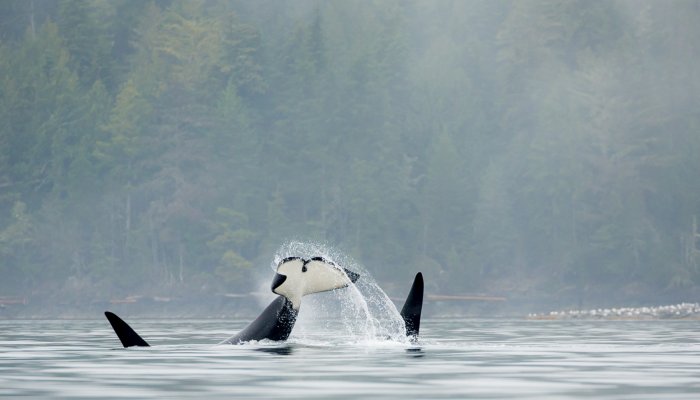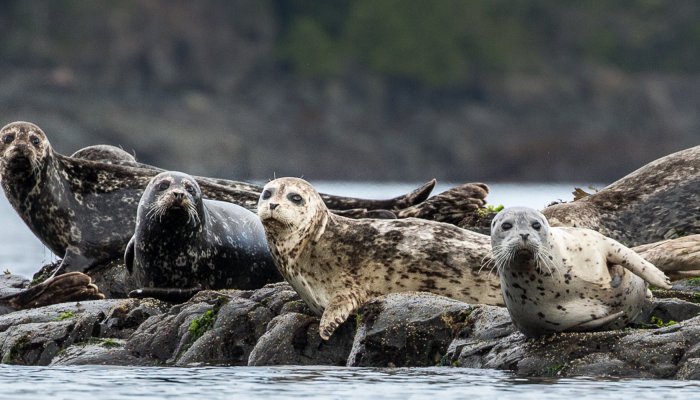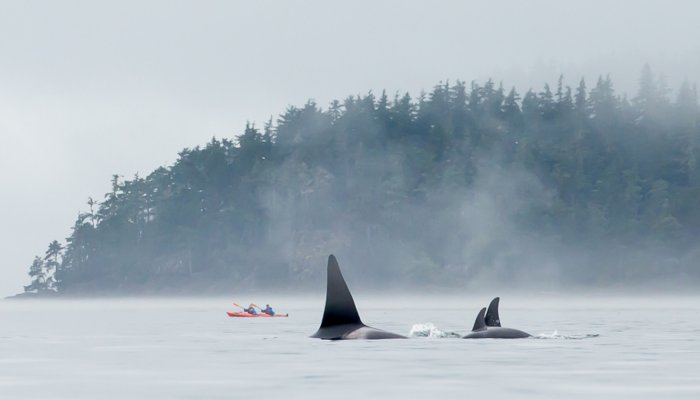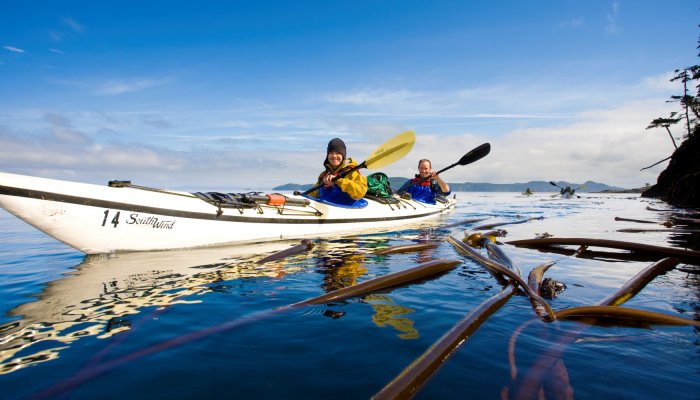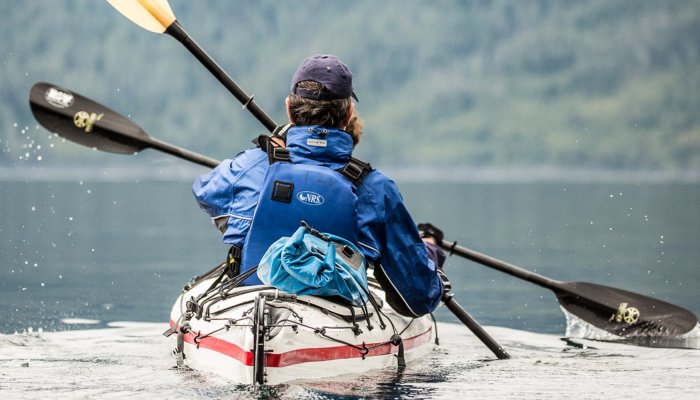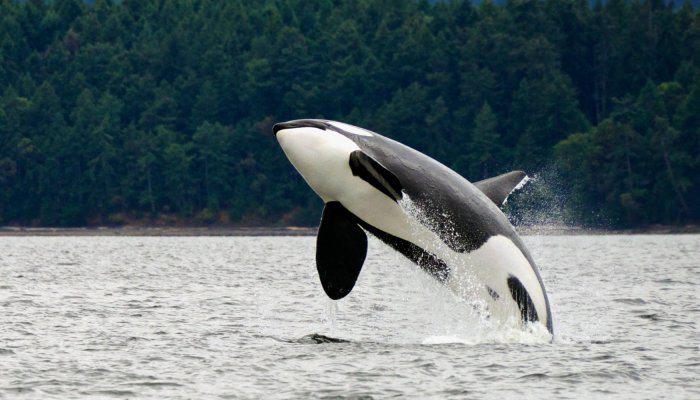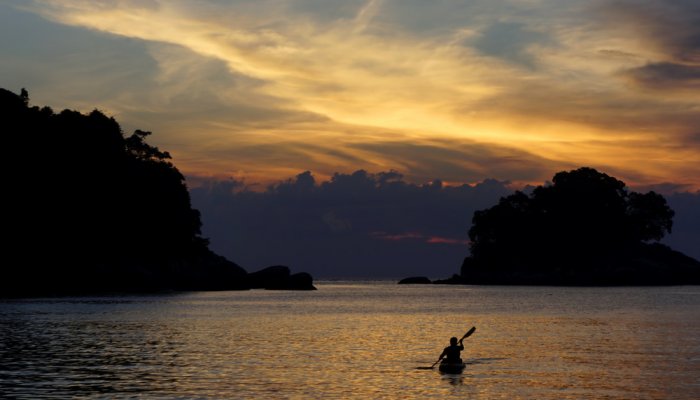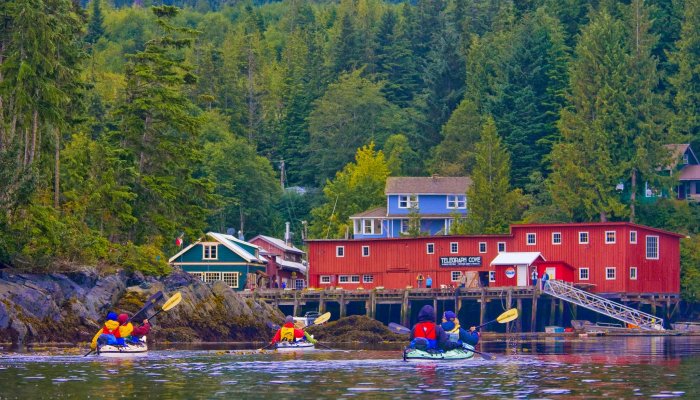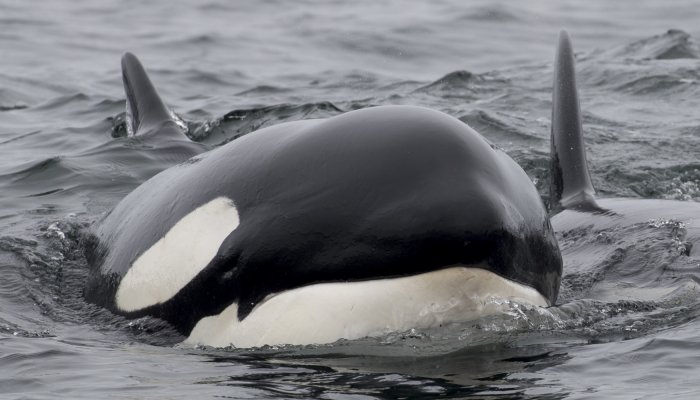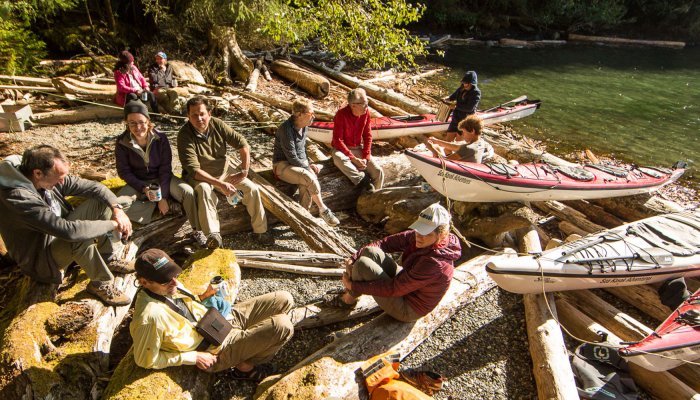Overview
British Columbia boasts a particular kind of beauty unlike any other region in the world. Home to majestic wilderness areas and rugged offshore islands, British Columbia is an adventure lover's paradise. Glacier-carved waterways, lush vegetation, warm summer weather, and iconic wildlife make BC a breathtaking vacation destination--especially for whale lovers. The Johnstone Strait has been called the premier destination for sea kayaking with orcas, with good reason. More than 220 of the black beauties swim through the channel each year.
Camping, whale watching, kayaking, and hiking are spectacular in BC. The region is home to the Robson Bight Orca Preserve, the world’s only orca sanctuary, and is also prime habitat for moose, eagles, and grizzly bears. With Adventures Unbound, you explore pacific beaches, alpine lakes, tranquil bays, and rainforest trails that are comparable to pages from a storybook. Our tours to British Columbia include kayaking through the tranquil waters of Northern Vancouver Island and hiking along the Pacific Coast, with overnight stays at the aptly-named God's Pocket Resort in Queen Charlotte's Straight. The region boasts a rich indigenous heritage as home to dozens of First Nations groups, as well as a paddock-to-plate ethos that ensures you’ll be treated to incredible cuisine. There is so much natural beauty to be admired in this part of the world, and we are eager to share it in a true unbound fashion! Whether you prefer camping or lodge-based adventures, we have the perfect itinerary for discovery by day and creature comforts by night.
Our Trips
Custom Tours in British Columbia
With Adventures Unbound, discover British Columbia’s magnificent landscape, and surrounding nature on foot or by paddle led by expert local tour guides who know the country’s landscapes, history, and culture like the back of their hand. Explore the picturesque coastlines off of Vancouver Island in a more customized and intimate travel style.
Working closely with local partners and affiliates in British Columbia, let us curate a private tour that reflects your interests, whether it’s whale watching, relaxing by the water, paddling and, or discovering history and culture of Vancouver Island. All of our customized tours in British Columbia include delicious local cuisine, and comfortable accommodations.
To get started, please fill out the form below, or you can learn more by reading some of our most frequently asked questions.
Image & Video Gallery
Country Guide
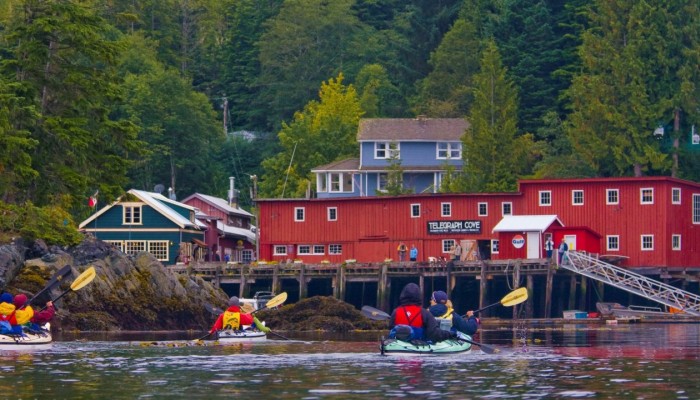
History of British Columbia
British Columbia is a freshly inhabited land. It was isolated during early human history by its complex geography. Ancestors to its many native tribes that compile the First Nations people trekked into the area near the end of the most recent ice age. The Bering Sea remained frozen while the ice floes that had covered much of Canada receded, leaving a carved out landscape that is still difficult to navigate today.
Early natives settled mostly in the southwest corner of BC. Plentiful resources, game and fish, natural barriers, and lots of space allowed for the formation of several different tribes. Individual island nations existed off the coast of the mainland. Mainland populations continued to grow and follow seasonal movements demanded by wildlife and weather.
Spanish and English expeditions in the late 18th century brought the first Europeans to British Columbia. The dominant Native culture interacted with fur traders and explorers. Trading posts and forts of historical significance turned into major outposts and cities. George Vancouver, Simon Fraser, James Douglas and others have been memorialized by having their names attached to sites across BC.
The gold rush of the mid-19th century brought governmental rule to British Columbia. Thousands of people hoping to strike it rich came to the area. When this exciting, though brief time span started to decline, the British influenced lawmakers decided to join Canada. Indigenous peoples remained as the highest population percentage until just before the turn of 20th century.
Booming extraction industry brought the need for labor into British Columbia. Upon completion of the Canadian Pacific Railway, Victoria gave way to Vancouver as the most populous city. Accessible natural resources of salmon and trees drove economic success along the coast. Mining and farming, as well as timber, were the focus of inland settlers.
Technological advancements combined with promotional language brought about a more welcoming climate than other Canadian provinces--in effect encouraging more immigrants throughout the 20th century. Asian communities are especially well represented among the diverse populations represented among British Columbia's residents. Vancouver hosts the second largest Chinatown community in North America.
British Columbia is not done growing as a powerful force in human history. The 2010 Winter Olympics were held in BC. Popular Hollywood film productions take advantage of a varied entertainment industry. Ecotourism is a rising force in the popularization of "going green." Other advancements are sure to take place as well. The future looks bright for British Columbia!
First Nations
Human history in British Columbia reaches back to the end of the most recent Ice Age. Nomadic individuals from Asia crossed a land bridge spanning the current day Bering Sea and settled coastlines from modern-day Alaska south. Unique tribes developed with specific customs and styles of speech. What became BC played host to 198 groups collectively referred to as the First Nations.
COASTAL TRIBES
Coastal tribes were the first to become permanent. Tlingit, Kwakiutl, and Gitxsan were among them. Origin myths abound, with many interpretations claiming an almost reincarnation feeling. Seagulls, orca, and grizzly bears are among the animals that were reported to turn into human form and settle. These histories were passed down through an oral tradition. Totem poles are another lasting remnant of these traditional cultures.
Fishing was a mainstay resource for the coastal First Nations people. Abundant marine life of all sort were respectfully harvested in order for the tribes to continue their ways of life. Berry picking, hunting, and even intertribal trading also took place. Kwakiutl, settled on Vancouver Island, likely dealt with the Gitxsan, settled on the mainland tributaries, who likely dealt with the Blackfoot Confederacy.
INLAND TRIBES
The Blackfoot Confederacy resided heavily inland. Trout and buffalo were the main animal resources among this migratory group of people. Seasons would see them move with the game they relied so heavily on for sustenance. With the movements, the Blackfoot Confederacy were key in helping the First Nations establish trade routes. British Columbia, by name, did not exist until the 19th century, but it was already connected with the rest of the North American continent by 1000 BC.
EUROPEAN ENCROACHMENT
Native ways of life continued through most of the 18th century. European explorers and fur traders brought major change to their ways of life at the turn of the 19th century. Expansion of English and Spanish forts and settlements brought disease and forced First Nations tribes to adapt to new ways of survival. Violence between Native and White populations was not as prevalent in British Columbia as compared to the rest of North America.
A series of treaties and requests from the First Nations tribes were repeatedly denied under the larger Canadian government's Indian Act. It was repealed in 1951, and continued reconnection with historic cultural ways continue today. Work between First Nations leaders and Canadian officials is ongoing. Successfully advancing relationships between varied cultural groups while respecting growth and histories makes these efforts vital.
Early European Explorers
BRITISH AND SPANISH EXPLORERS
Spain and Great Britain were the first countries to establish European contact with British Columbia. A ship under the command of Juan José Pérez Hernandez, a Spanish captain, is popularly believed to have been the first European expedition to see its coastline in 1774. His expedition communicated and traded with local native populations. He also announced Spain as the ruling owners of this new land. Esteban José Martinez founded the first colony, a fort in Nootka Sound, in BC in 1789.
James Cook, sailing under the British flag, landed on Vancouver Island in 1778. The two ships commanded by him stayed on the Pacific side of Vancouver Island. British fur traders worked with First Nations tribes to develop a successful operation. Spanish interests grew defensive of these British advancements, and a dispute led to several years of considerations. Eventually, both countries were granted equal trading rights.
George Vancouver, a British naval officer traveling with James Cook, spent much of his time completing the mission of mapping the coast. Many names he gave to the places he traveled still exist. Completion of this mission was a major boon to British claims in BC.
Inland regions saw more Europeans with the turn-of-the-century. Alexander Mackenzie, Simon Fraser, and David Thompson all made significant early expeditions through the region. Each was an employee of the North West Company.
- Alexander Mackenzie came from the East in 1793. He explored the central BC Chilcotin Plateau, as well as more northern reaches.
- Simon Fraser spent much of his time establishing settlements along the fur trading route between Montréal and British Columbia. Fort McLeod, Fort St. James, Fort Fraser, and Fort George were all his doing. A botched expedition, believed to have been charting the Columbia River, drew the ire of many of his assistants.
- David Thompson, eventually named it the Fraser River. Simon Fraser had previously named another river the Thompson River for his colleague. David Thompson was more successful in mapping the headwaters of the Columbia River. His expeditions also came to assist the Canadian government in choosing the 49th parallel as the border with the US. Thompson spent his love life with a mixed race (commonly referred to as a Métis) First Nations woman named Charlotte Small. They eventually had 13 children together, and his family often accompanied him on adventures.
Fur traders and mapmakers dominated the limited number of settlements in British Columbia until nearly 1860. It is a popular timeframe for "True West" mythologies and dreams surrounding manifest destiny. Relying on nature for everything certainly paid off some, but the discovery of gold would prove to usher in a new era!
Gold Rush
GOLD: NOT YET A RUSH
British Columbia was a sparsely populated region dominated by First Nations tribes and fur traders until 1850. Gold was discovered in one of the northern island chains, the Queen Charlottes, and the beginning of a new era was begun. This first race for riches seemingly yielded less gold than worth the trouble, but British interests were rekindled enough to lay further claim to the region. Americans could not be allowed to dominate the entire West Coast of North America if there was gold to be had!
Trace amounts of gold started popping up in fur trader journals since the 1830s. Companies who employed these men did not want news of these findings to spread. It could have ruined the fur trade. One of the First Nations tribes, the Secwepemc, brought a substantial amount to the attention of Victoria and Vancouver Island Governor James Douglas in 1856. He knew a land dispute with the USA was imminent and forced Britain's hand in the matter by sending the gold to San Francisco. The public had been alerted, "There's gold in them thar hills!"
THE RACE FOR RICHES
Immigration and mining economies exploded along rivers in British Columbia. The port city of Victoria, previously home to hundreds of people, grew to over 30,000 residents almost overnight. Most people were arriving by boat, making it a natural place for businesses to set up. Mainland, then called New Caledonia, is where the majority of the gold was found, but almost everyone stopped in Victoria on their way.
Fort Yale was a major hub in the early gold rush activities. Native populations, as well as varied European and American groups, worked alongside one another in peace and war. Deaths coinciding with the rush, due to smallpox and murder, numbered into the thousands. No formal numbers can be tallied, but the Fraser Canyon War was the bloodiest of the battles. It was started over the rape of the French woman. McGowan's War, on the other hand, ended without a shot being fired. It was politically charged and dealt with the protection given by Fort Yale to a black citizen of the USA. Both wars proved the need for further governance. British Columbia officially became a Canadian province in 1871.
More people in British Columbia meant more areas were explored in depth, leading to further gold discoveries. The Fraser Gold Rush shifted into the Cariboo Gold Rush. The timing of this gold rush coincided with the American Civil War. British interests were aided by USA miners moving closer to home. Skirmishes and deaths were frequent between the remaining minors and native populations. British movements refused to stop, though. First Nations tribes were mandated under the Indian Act near the end of these rushes.
Many settlements that became established during these gold rushes still exist today. Mining moved in different directions because the amounts of gold were not worth the efforts exerted on such a large scale. Still, the population boost brought into British Columbia during the Gold Rush Period forever impacted the region.
Urbanization and Growth
INDUSTRIALIZATION AND IMMIGRATION
British Columbia grew in population nearly four times between 1881 and 1901. The transcontinental railroad completed by the Canadian Pacific Railway Company deserves most of the credit. Promise of a completed railway that would unify Canada helped solidify the integration of BC as a province in 1871. Construction of the railway completed in 1885.
Workers of varied ethnic backgrounds contributed to the project. Asian communities, especially Chinese, Japanese, and South Asians were employed as laborers. After the completion of the railway, the populations stayed as permanent immigrants. Turn-of-the-century demographics were heavily bent toward English ancestry. Roughly 75% of British Columbia's residents were white.
PURSUIT OF ETHNIC INTEGRATION
Racism ensued. Anti-Asian riots took place. A ship called the Komagata Maru, with over 300 would be immigrants on board, was told to go back where it came from. Government forces plotted against Asian residents, even going so far as to remove them from their homes and place them in internment camps during World War II. Finally, in 1949, the politically sanctioned race divisions were completely abolished. Today, Vancouver hosts the second largest Chinatown district in North America.
URBAN GROWTH
Logging, fishing, mining, and other industries continued to expand through British Columbia during these years. Eastern provincial locations were among the first to grow from forts and trading outposts into cities. Prince George, Nelson, and Kamloops are prime examples of cities that would have been lost without the railway completion. Today, some of the most scenic drives in Canada, including the famous Selkirk Loop, provide easier transportation for people and goods.
Availability in technology, along with worldwide demand you wood, kept British Columbia increasing its pace of forestry production. After World War II, it became less necessary for such a large percentage of residents to work in the thriving outdoors industries, and urban growth began in earnest. More than 1 million people called BC home by 1950. Nearly 70% of them lived in the cities.
Expo 86 and the 2010 Winter Olympics proved to be crowning showcases of British Columbia to the world. Vancouver is home to more than half of the provincial population, and it proved to be a wonderful host for both of these events. Transportation and Communication were the focus of Expo 86, with heavy emphasis on world movement. Over 20 million people attended in the 5 months it was open.
Steady growth continues across British Columbia. Things are no doubt easier today on the residents, and life continues to be more convenient. Safety for individuals is at an all-time high. Urban environments invite city-folk to world-class amenities while large swaths of untouched wilderness remain for those looking to get out of town. In either scenario, it's an exciting time to be in British Columbia!
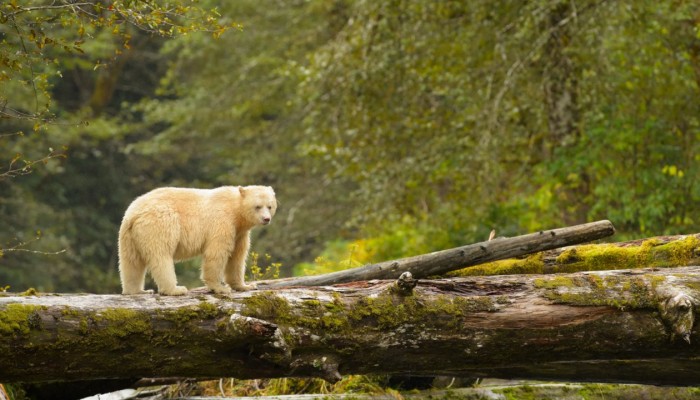
Animals of British Columbia
Big country, big game. British Columbia does not hold back when it comes to biodiversity. Pacific Northwest living is especially well-suited to large animals that used to dominate the landscape of the North American wild.
Mountainous regions butted right up against the ocean make for unique interactions between creatures that generally don't meet. Migratory flocks of birds along the coast and inland exist in great numbers. Seasonal changes affect more than the winged creatures, though. Big-game animals in BC frequently only take advantage of short distance elevation changes in their movements to find habitable zones. Key to both of these shifts in yearly behavior are food resources, including smaller living creatures. The predatory food chain in British Columbia is also steep.
Waters along the coast and in between the islands are also rich in life. Schools of fish, marine mammals that chase them, and living underwater structures make British Columbia's coastal region someone the most alive in North America!
Birds
British Columbia's provincial bird may be the Steller's Jay, but a wide and diverse selection of birds commonly flock to BC.
Over 500 species have been described in BC since the mid-19th century, with over 450 of them still viewable. British Columbia is a part of the Pacific Flyway and is visited by migratory birds along several overland and coastal routes. Vagrants, or birds that do not generally inhabit an area, are common in BC and account for some of the diversity in the province.
Birding is an extremely popular pastime among outdoor enthusiasts in British Columbia. Seasonal species are especially looked out for and noted for their migratory patterns. Large birds of prey, Eagles and Hawks of several variety, are not nearly as prized to view as some of the smaller songbirds. The George C Reifel Bird Sanctuary boasts that people have spotted 240 species on its 850 acres.
It does not matter where a person is in British Columbia, there is always a winged creature to look out for. Make sure and keep a pair of binoculars handy, and maybe even invest in a journal to keep track of how many species you see. There are birder communities everywhere who will be interested in your discoveries!
Fish
British Columbia plays host to a slew of fresh and saltwater fishes.
British Columbia is home to some fish species that, like each subspecies of salmon, are anadromous, meaning they begin their lives in freshwater before migrating to saltwater to mature and eventually returning to spawn in freshwater. Opposite of that, eels are catadromous.
SPORT FISHING
Sport fishermen typically pursue only a few of BC'S FISH species. Salmon are especially sought after while they mature in saltwater and as they stage for their spawning runs. Prize among them is the Chinook, sometimes weighing in excess of 50 pounds. Making that look small, however, is the Pacific halibut. They are flat predator that live along the bottom of the ocean. Weighing up to 400+ pounds, most halibut caught are between 20 and 40 pounds. Generally speaking, halibut over 70 pounds are breeding females. Lingcod and other rockfish are also prize table fare.
FRESHWATER FISH
81 species of native freshwater fish have been described in British Columbia. Ruler among these, in size at least, are the white sturgeon. They have been known to live upwards of 100 years and grow in excess of 18 feet! British Columbia has a population of white sturgeon in two of its three major drainage systems: the Fraser River and the Columbia River. Because of their slow maturation process, white sturgeon are especially prone to failure numbers due to fishing pressures. Conservation tactics are constantly being adjusted.
The other main fish in the British Columbia freshwater system is the salmon. Six different species fill the rivers and lakes during nearly spawning runs after returning from years in the ocean. First Nations tribes in BC historically survived on these bountiful fishes, but numbers have been devastated by fishing pressures and other environmental consequences of mining and resource mismanagement. Still, numbers are high enough to support a thriving sportfishing industry that draws thousands of visitors and inserts millions of dollars into the British Columbia economy each year.
SALTWATER FISH
Saltwater fish diversity is off the chart compared to the freshwater fishes. 409 species in the Canadian zone of the Pacific Ocean have been identified. Of these, 25 are found in both fresh and saltwater. The zone extends 200 miles offshore. Further extension reaches international waters, where there are even greater numbers of species available.
SHELLFISH
Shellfish such as oysters, clams, prawns, and crabs are also common. It might come as no surprise that seafood is a mainstay on the plates of people who live in British Columbia!
Mammals
British Columbia is home to more species of mammal than any other Canadian province.
BC's high mammal percentage is owed to so many reasons, especially the vastness of the landscape playing host to the wildlife. Extending nearly 1000 miles north to south and 400 miles east to west, BC has enough room and zones for such variety.
That being said, insular regions such as the islands contain many fewer types of mammals than the mainland. Water boundaries seem to play a more important role in excluding diverse populations than do the mountains of the mainland. These separations have also led to scientific discussion regarding subspecies, and research is ongoing in regards to how island populations might differ genetically from mainland populations.
Land Mammals
Land mammals are even more diversified. Over 100 native species can be found across British Columbia. The Interior Plateau is where the highest concentration of multiple species exist. Big game species get the most press, including Whitetail, Mule, and Fallow deer, moose, caribou, elk, mountain goat, bison, and sheep. These herd animals were historically significant for providing food sources and other materials used by First Nations tribes for survival. They also serve as prey to the populations of large carnivores still exist in British Columbia.
Grizzly and black bears, cougars, gray wolves, wolverines, badgers, bobcats, foxes and more make up a thriving population at the top of the food chain. These predators are all fierce in their own way, but they are also majestic pieces to the natural puzzle that is the British Columbia wild. Governmental protection has been passed down for many of these animals in order to keep the system healthy. Don't go into the woods unprepared, though!
Fur traders were especially interested in BCs population of otters, mink, and beavers. These species still exist in good numbers today. Other small squirrels and rodents are abundant as well! Included among them are 4 species of chipmunk and 3 species of marmot. And a person would be remiss to forget about the more than 15 species of bat living in British Columbia. There are definitely no shortages of mammals that take advantage of this province!
Marine Mammals
BC is home to a wide variety of marine mammals who trace diverse evolutionary paths. For instance, there are 5 members of the earless seal family Phocidae--a family with 6 separate distinctions with multiple species per family; all this underneath the order of Cetacea, commonly known as whales and dolphins!
The most picturesque and famous whale in British Columbia reality and folklore is the Orca. Resident and transient pods frequent the rich waters along the coast. Humpback whales are another commonly experienced and photographed member of the whales. There is predation between marine mammals, as otters, porpoise, and multiple species of sea lions are primary food sources of toothy whales in the area.
Reptiles & Amphibians
REPTILES
British Columbia is a northern province, meaning there is not much consistent warmth for warm-blooded reptiles such as snakes, turtles, and lizards to live in safely. Still, some species exist here.
AMPHIBIANS
22 species of amphibians live in British Columbia. Many of these species are peripheral, meaning their normal range is outside of BC. Frogs and toads (13 in total) and salamanders (9 species in total) make up the amphibian population.
A person is most likely to encounter one of British Columbia's amphibious residents in the southern regions. Lakes and slow-moving rivers host most of the species, but a few have adapted to the fast water found in the lower elevation, mountainous zones. Especially keep an eye out while visiting the temperate rain forests of BC!
SALAMANDERS
Unlike typical amphibians, some species in BC do not divvy their lives between land and water. Tiger Salamanders, for example, spend their entire mature lives underwater. In opposition, Wandering Salamanders lay their eggs on land.
SNAKES
Nine species of snakes are spread across the southern half of British Columbia. One third of the species are varieties of garter snakes, including the Western Terrestrial, Northwestern, and Common varieties. Rubber boas, gopher snakes, and racers make up the rest of the non-venomous species present throughout BC. The only venomous snake present is the Western Rattlesnake. Arid regions are the most likely places to encounter rattlers, especially the Okanogan Valley in south-central BC.
LIZARDS
Three species of lizard also inhabit South BC. Furthest reaching among them are the Northern Alligator Lizards, which inhabit coastal, mountainous, and inland plateau regions. The Western Skink generally sticks to the more arid region of the Southern Interior. Most isolated in habitat among British Columbia's lizards are the European Wall Lizards. They can only be found in the city of Victoria.
TURTLES
The largest sea turtle in the world, the leatherback, is an infrequent visitor to the waters off BC's coast. It is considered threatened in the region. Fishermen sometimes haul in dead leatherback turtles in their longline sets. Sightings date back to 1931.
The smaller, freshwater Western Painted Turtle, inhabits most of the southern half of British Columbia. The Red-eared Slider is another freshwater turtle that inhabits southern reaches of BC, including Vancouver Island.
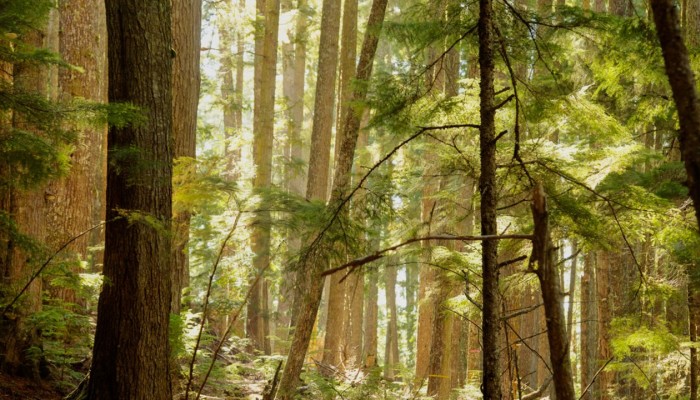
Flora of British Columbia
Covering the span of undergrowth to old-growth trees, over 3000 species of plant life are native to British Columbia.
Two temperate rain forests, coastal regions, mountainous zones, and an area of arid plateau are each adorned in differing styles. Because of the geographic sprawl found in BC, there are vast differences found in every direction. Each form of plant life adds to the natural wonder that is British Columbia. With so many species in every region, it's good to familiarize oneself with the basics, but be prepared for something new.
Coastal Rainforest
One BC's primary rainforest regions is the Great Bear Rainforest, stretching over 12,000 square miles. Roughly 100 inches of rain per year falls in this region! This land is so rich in plant and animal life, that some have referred to it as the Amazon of the North. Western Red Cedar and Sitka Spruce are two of the species of trees dominant here.
Some of the cedar trees are over 1000 years old while some of the spruce grow to 300 feet tall! Other large conifer trees also feature here: multiple species of hemlock, pine, and Douglas fir. Deciduous trees are less common, but because the temperatures remain moderate year-round, Big-Leaf Maple are a part of the equation.
But rainforests are not all about trees. British Columbia's coast also plays host to a wide variety of moss, lichen, ferns, bushes, and even grass. Epiphytes are plant life without roots, and in the Great Bearcat Rainforest, they can be found hanging most everywhere. Some of the more common species are Dicranum fuscescens, Scapania bolanderi, and Bazzania denudata. Aside from the scientific names, these different style of mosses and lichen cling to the bark of trees at different elevations, creating a density of plant life unrivaled throughout most of North America.
Ferns and bushes, some with berries, are also spread throughout the rainforest. Two of the most dominant fern species are the sword and deer ferns. Among the bushes present, one of the most popularly sought after by humans and animals is the huckleberry. These moderately sized bushes produce one of the tastiest treats enjoyed by herbivore and omnivore residents of the forest.
Southern Mainland
British Columbia is a mountainous region. Where elevation changes so steeply to disallow prairies, there are more than enough trees to compensate in the presence of plant life. Species of conifer cover every hillside until the elevation gets so steep that only the rock and ice remain.
Since most of the rain falls on the coast, BC's interior mountains generally do not carry the plethora of undergrowth seen in the Great Bear Rainforest. A wider variety of trees are found inland because there is so much more room for them to spread out. Multiple types of spruce, fir, pine, and larch dominate the evergreen populations.
Deciduous trees are more common inland as well. Aspen, alder, cottonwood, birch, maple, and oak add to the rich habitat for wildlife that is found in this area of BC. Since deciduous trees lose their leaves every fall, some spectacular vistas can be seen while driving through British Columbia's mountains.
Lowland plateaus carry completely different styles of plant life. It is here where a person can find British Columbia's provincial flower: Cornus nuttallii, of the Dogwood family. Sage brushes and bunch grasses are among the scrub style of scattered flora. It is interesting to note that several scrub species of plant life also form above the tree line on mountains before giving way to a lack of soil. One such order that propagates several species is Vaccinium.
Bromegrass, fescue, and hairgrass can be found among the relatively few pockets of protected rainshadow lowland in British Columbia. Big-game of all sorts rely on habitat convergence areas like these grassy fields for continued health and a balanced ecosystem.
Inland Rainforest
British Columbia's Rocky Mountains are hiding one of the world's best-kept secrets: the Incomappleux Valley. Loggers found this wet region in the 20th century and proceeded to harvest as much wood as they could. This process came to an end in 2003, and a clear-cut region with a lone tree dating back to 1800 years still standing is a sign that conservation is the new direction.
Another name this region goes by is the Valhalla Rainforest. It lies along the western edge of the Rocky Mountains, collecting heavy rains as weather systems stack up against a natural barrier. It is dominated by a combination of cedar and hemlock trees dating back more than a millennium in places. 21st-century science expeditions continue to describe a wealth of information regarding floral species sometimes thought to have been extinct. One such species of concern is the Nephroma occultum.
Lichen species are still being discovered in this area. 40 potentially new species were being examined in 2007 following verification of 13 guaranteed newly discovered species. This form of plant life serves as a natural fertilizer by collecting environmental nitrogen and aiding in tree growth. Nearly 300 species of lichen have been described in this rich region.
Other valleys in the Valhalla Rainforest region of British Columbia remain largely unexplored. Rare orchids, worts, mushrooms, and shrubbery are found nearly every time someone ventures into the wilderness here. Plant enthusiasts really need to take advantage of this South Eastern BC hotspot for scientific discovery!
Northern Interior
Remote, rugged, cold, wild. British Columbia largely exists in this region the way it has for thousands of years. Grasses are the dominant feature of the northeastern section, which happens to be the edge of the Yukon Plateau. These grasses have been at the center of continued studies as recently as 2011 to help further the understanding of northern BC's flora. Bentgrass, orchard-grass, and oatgrass are a few of the species present that have been defined.
Wildflowers are also found in abundance in this area of British Columbia. Orchids, lilies, poppies, and so many more are scattered along the ground. There is a relatively short growing season in North BC. This means that some of the plants shielded from heavy precipitation in the southern regions are also visible here. For example, several species of flowering willow shrubs decorate the area.
Trees are not uncommon in northeastern BC. Stands of birch and spruce thrive in the soil present. Aspen and other deciduous trees are also found here. Conifers line the hillsides surrounding the plateau.
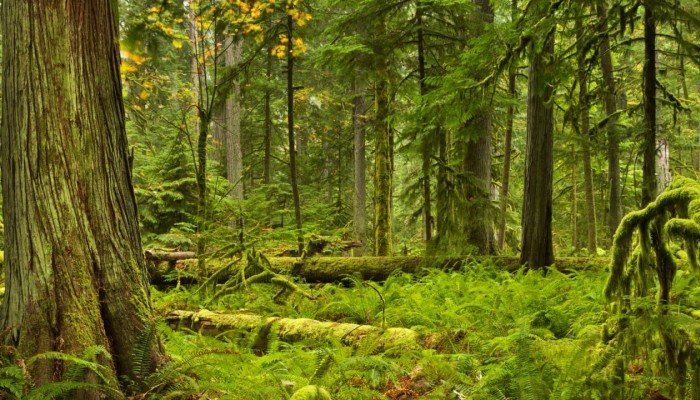
Conservation in British Columbia
Conservation Efforts
There is a long history of conservation in British Columbia. Stretching back to 1859, governmental forces have been working to protect the animal resources that help to first pique European interest in this great section of the Pacific Northwest. Other natural resources began to be regulated for the betterment of everyone on July 1, 1905 with the opening of the Department for the Protection of Game and Forests. Since then, plenty of new incarnations and changes have morphed into the Ministry of Environment.
As of 2016, major responsibilities for the Ministry of Environment include figuring out appropriate responses to climate change, keeping water laws updated, being prepared for environmental emergencies, and dealing with an extensive provincial parks service. Pollution and poaching are taken very seriously, with citizens encouraged to report any such behaviors. Frailty of the splendor that makes British Columbia, even with such vast natural resources available, is a very real concern.
Cultural conservation, especially surrounding First Nations Tribes, is gaining ground. Aside from the government office regulating historic places, each specific tribe under the First Nations umbrella is working hard to regain and hold on to their histories. Laws under the archaic Indian Act were extraordinarily oppressive and continue to need updating so that the indigenous people of BC can regain the respect they deserve.
Museums and living history sites abound throughout the populated regions of BC. Labor forces since the 1850s have passed down not only their bloodlines, but important pieces of the puzzle that is continuing to be built today. Since the growth of British Columbia is still in its younger phase, compared to so many locations around the world, here is a place where conservation efforts are working in a proactive manner.
Continued progress in technological advancements combined with caution where natural and cultural resources are concerned means that British Columbia will maintain its splendor forever!
British Columbia National Parks
Much of British Columbia falls under various designations of parkland. More than 800 individual areas carry a level of protection from being cultivated or technologically advanced. Seven of these areas fall under the greater protection of being part of Canada's National Park system. These include Glacier, Gulf Islands, and Pacific Rim National Parks.
Next in line are the provincial parks, which are run by the BC Ministry of Water, Land and Air Protection. It is the largest system of parks controlled by any individual Canadian province, hosting five times as much hiking trails as it does roads. Provincial parks are located across BC, from the Yukon to the US, from the Pacific to Alberta.
There is no shortage of land, and water, managed for your exploration in British Columbia. In all, nearly 13% of the province finds itself under the protection and promise of being kept in its natural state!
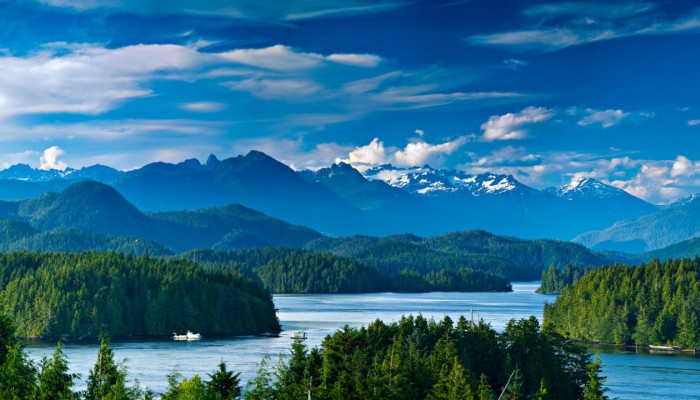
Geology of British Columbia
British Columbia is physically impressive: prehistoric mountain ranges, highlighted by the impressive Rocky Mountain range, stack up against each other.
British Columbia's mountain ranges are separated by plateaus in the lower elevations. Sections of BC reach far into the northern hemisphere, meaning relatively recent ice ages have been pivotal in its terraforming. Bordered by the Pacific Ocean along its west coast, BC is naturally part of the geologically active region known as the Pacific Rim. Plate movements are especially mobile along the southwestern edge of BC, near Vancouver Island. British Columbia's land history is laid bare for enthusiasts to discover and witness the creation of more!
Ranges & Valleys
British Columbia can mostly be divided into five vertical line sections. These coincide with a series of mountain ranges separated by low lands of varying condition. Differing styles of rock compose each unique range. Northern reaches of BC have been geographically measured as older than southern regions.
The westernmost mountain range in BC is known as the Insular Range. The Insular Range formation is comprised of rocks that make up the islands along the coast, including Vancouver Island and the Queen Charlottes. Ice ages in the past have dried enough of the ocean that the seafloor between the islands and mainland was exposed. The Insular Range features a mix of sedimentary and volcanic rock. One of the highest peaks in this range is the Golden Hinde, reaching over 6600 feet. For comparison sake, mountains in the interior ranges reach as high as Fairweather Mountain at 15,000 feet!
British Columbia's mainland Pacific coastline is made up of the Coast Mountains. The Coast Mountains extend from the Alaskan border in the northwestern section of BC along the ocean all the way south to the border with Washington State. Very few sand beaches exist in this rocky, volcanic environment. A few rivers carve their way through the range, most notably the Fraser River in the Southwest. This mountain range, formed by prehistoric eruptions, is almost 200 miles wide and 1000 miles long. Granite and other metamorphosed rock comprise their make up. Glacial ice still covers great sections of the Coast Mountains where BC's border moves away from the ocean along its border with Alaska, where sits Fairweather Mountain.
The Interior Plateau sits in between the mountain ranges of British Columbia. It especially is situated center province and south of the Interior Mountains. This is the least rocky geologic portion of BC, containing most of the 3% of provincial land that is farmable. Four named sections of this plateau exist: the Cariboo, Chilcotin, Nechako, and Thompson plateaus. Boundaries for these include rivers and mountains.
East of the Interior Plateau region, the Columbia Mountains streak north from the United States border until forming into the Interior Mountains. Geologic makeup of this zone means several smaller ranges have collided to create the greater whole. Since this amalgamation of rocky structures is less uniform, there are a number of passes between interior communities. Some of the world's favored geologic explorations occur in this region.
Finally: the Rocky Mountains. North America's great range runs along the eastern border of British Columbia. The Rocky Mountains lies in northeastern BC where the range finds one of its ultimate ends--the other end being over 3000 miles away in the United States' New Mexico. Sedimentary rocks dating back over 2 billion years comprise much of the range. The Rocky Mountains Trench is situated along the western edge of the mountains. Headwaters of the Columbia, Fraser, Kootenay, and other major rivers can be found in this 900-mile stretch.
Ice Age Effect
British Columbia's coastline is a testament to the power of ice. Deep fjords formed from sheering ice evidence trace BC's geologic history. 35,000 years ago, the Fraser Glaciation began in earnest. Advancing fields of ice covered interior regions as well, stopping near the southern edge of BC. lateaus in the center of British Columbia are also riddled with signs of the last Ice Age. Further, a pair of large icefields can be found along the eastern and western edges of BC. The Columbia Icefield, along the Alberta border in the Rocky Mountains, is the largest in the range. The Juneau Icefield helps to define British Columbia's border with Alaska. It is one of the largest ice fields in the West. Both have seen a major trend toward retreating ice in recent years. Tourist opportunities are offered to help individuals experience the power that is ice in action!
Glacial Terminology
Erosion is the primary chiseling tool of glaciers. When the massive amounts of ice move across bedrock, but do not carve it out, this is called abrasion. Quarrying is when the glacier actually removes pieces of the underlying bedrock. Everything that is moved by a glacier has to be put somewhere else. This is called deposition. It mostly takes place while ice is retreating.
Moraines, uneven ground across the relative flatness of the low lands between valleys, are created by deposition. These include ridges, washboard mounds, and oddly shaped soil and rock structures. Material of all sorts them be found in these moraines. Clay, sand, rocks, and other molecular combinations get all mixed up through the process of glacial movement.
Plate Tectonics
British Columbia's land, especially along the western edge, is affected and formed by massive plates that are still moving today. Three types of boundaries construct the way these plates interact with each other. These interactions are called tectonics. When movements occur violently enough, plate tectonics create earthquakes. BC is rich in earthquakes.
Convergent tectonics are the most apparent and possibly destructive to people in British Columbia. The Juan de Fuca Plate is pushing underneath, the act of subduction, the North American Plate. This region is known as the Cascadia Subduction Zone. It runs from Northern California to Vancouver Island. Pushing Earth's crust beneath other parts of Earth's crust can lead to the creation of mountains.
Volcanoes and earthquakes are both fueled by the natural act taking place in Earth's crust. British Columbia's most recent eruption took place at Mount Meager in approximately 300 BC. Contrary to the millennia separating us from volcanic activity in British Columbia, earthquakes strike the region frequently. A 4.7 on the Richter scale, powerful enough to wake people though only minor damage and no injuries were reported, shook Victoria in December 2015.
The most powerful earthquake in Canadian history took place at the strike-slip Queen Charlotte Fault in 1949. It was an 8.1 on the Richter scale. Strike-slip faults are sometimes referred to as transform faults. These occur when two plates strike against each other while moving in opposing directions. In this scenario it was the North American Plate and the Pacific Plate.
Least destructive among the plate tectonics in British Columbia are those classified as divergent. There is a place under the ocean, not quite 175 miles off the coast of Vancouver Island, where the Juan de Fuca Plate is pulling away from the Pacific Plate. This is creating an opening for magma to seep onto the sea floor and create new ocean crust. British Columbia, a place that already offers so much to so many, is working on growing more land, just for you!
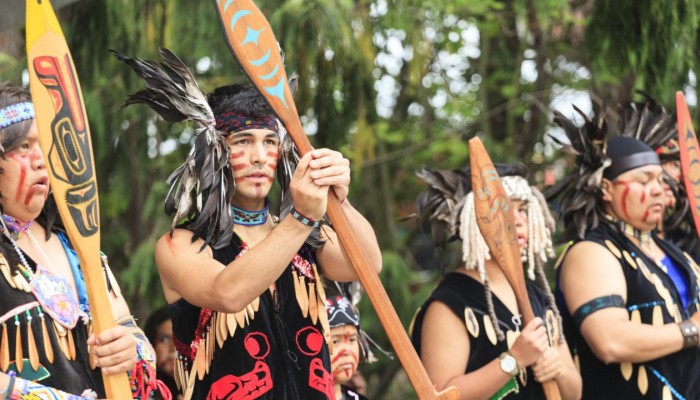
Culture in British Columbia
There are three primary groups to be studied in British Columbian culture: First Nations Tribes, Europeans, and Asian immigrants. There is also a hearty differential between urban and rural lifestyles available in BC. Each of these groups have assisted the other in building one of the most diverse, and ultimately welcoming, places on the planet.
Native Life
British Columbia was originally home to hundreds of individual tribes. Near the end of the last Ice Age, the first humans to land in the area came across the land bridge from the Bering Sea. Abundant game and marine resources invited long-term settlement. Thousands of islands promoted unique tribes to exist without much crossover.
Indigenous History
It is believed as many as 25% of the population of any given tribe was comprised of slaves taken from other tribes. These workers were assimilated as workers into a population after they were taken from their home tribes. In a memoir titled A Narrative of the Adventures and Sufferings of John R. Jewitt, Englishman John Jewitt detailed his experience of being a slave after his ship sank.
Spanish and British explorers came to British Columbia in the late 18th-century. Settlements and disputes between governments from afar eventually led to British rule. Many of the cultural aspects considered normal to First Nations tribes terrified the British. Potlatch, a gathering of tribes that celebrated several cultural aspects including dance and union rituals, especially bothered the unfamiliar newcomers.
In 1876, the Indian Act granted Canadian officials governance over First Nations entire lives. This included whether or not an individual with tribal background could maintain status as a tribal member. It even outlawed the potlatch ceremonies. A stated goal of assimilation into a more modern society through the education of good morals the driving force behind this act. Potlatch ceremonies were reinstated as legal in 1951, though they had continued "illegally" regardless what the law said.
Amendments and adaptations have updated the Indian Act, though it is still in effect. Cultural rights on reserve land must adhere to guidelines upheld through several challenges to the Indian Act. Human rights violations are taken seriously by Canadian government, as defined in the passing of the 1977 Canadian Human Rights Act, but even it provisionally written to exclude individuals covered under the Indian Act.
First Nations Tribes Today
Frustrations of wanting self governance aside, First Nations tribes are steeped in dance, historical oration, origin histories, and natural ways of interacting with various resources. Over 200,000 individuals identified as members of 198 tribes who speak as many as 60 different dialects in a 2011 survey British Columbia. The majority of these peoples can be found in the southwest island and coastal communities. Totem poles are the most commonly recognized artwork of these tribes. By name, they include Haida, Nootka, Tagish, and many more. Interior tribes included the Carrier, Kootenay, Salish, and more.
Many tribes promote their history and ways of life through tourist attractions. Immersive experiences are available for people who are most adventurous, while museums and gift shops are also readily available for perusal!
Euro-Centric
British Columbia has undergone a major cultural shift since the late 18th century. A plethora of unique native cultures that were around for thousands of years have been supplanted by the European way. Explorers from Spain and England were drawn to the region, and life has been forever changed.
Europeans Sweep into British Columbia
Natural resources dominated the early settlement of British Columbia. Fur traders were the primary residents for the first half of the 19th century. Small forts and trading outposts were the population gathering points. Local native populations were encouraged to deal with the new economy, though skirmishes did occur.
The advertised discovery of gold in the 1850s led to several years of major gold rushes. European populations boomed as troves of people sought riches. The southwest corner of BC, especially Victoria, was the hub for most major activity. It grew from a city the size of just hundreds o to over 30,000 people in a few short months.
Promise of a completed transcontinental railroad was among the main reasons British Columbia joined the nation of Canada in 1871. Migrant laborers, from Asia especially, joined in the construction force and the railway was completed in 1885. Still, the vast majority of the 27,000 people living in Vancouver only 15 years after its settlement were European in descent.
Christian morals dominated every facet of early British Columbia life. Laws were enacted to force First Nations tribes and Asian immigrants alike to adhere to unfamiliar ways of life. Customs defining community, let alone religious experiences, were deemed illegal and nonwhite populations were frequently isolated and constantly belittled in their existence.
Cultural Expansion
Abundant natural resources led to the expansion of extraction industries such as mining, logging, and fishing. Geographic isolation throughout BC meant that individual cities largely remained independent of one another. Southwestern sprawl around Vancouver and Victoria, where over half of the population of BC lives, is the exception rather than the rule.
Canadian laws have significantly expanded the rights of non-Europeans since the 1950s. Relaxation of strict civil considerations have led to the embracing of multiple cultures. Blanket equality for all groups still has a ways to go, but diversity between populations has become a point of national pride, rather than a splitting point.
Various forms of visual and performance art, lifestyle learning opportunities, and sports provide human focused entertainment. And a person would be remiss to forget the plethora of nature-centered entertainments available in BC. There is literally an option for everyone waiting to be discovered!
Asian Influence
Vancouver, BC hosts one of the largest Asian communities in the Western world. Nearly half of their population have Asian heritage, the highest percentage among major cities foreign to the Asiatic continent. They represent the third longest historical demographic in British Columbia.
Chinese Influx
European explorers employed Chinese workers on their expeditions in the late 1850s, but it was not until the 1850s gold rush that major immigration began. Labor opportunities offered better wages than those available from the varied countries the immigrants hailed from. Near the end of the gold rushes, businesses owned by Asians formed the beginning of what would become successful Chinatown districts in Vancouver and Victoria.
Canadian government hoped to stem the influx of otherworldly cultures with the passage of the 1923 Chinese Immigration Act. These new regulations eventually coincided with the Great Depression and rural immigrants moved back to urban environments in order to be supported by like individuals. The act was repealed in 1947 and all anti-Chinese laws were removed from the legal system in British Columbia circa 1951.
Asian Influence Today
Gardens are a very visible cultural influence on British Columbia. Agricultural expansion in the USA meant the decline of economic possibilities for immigrants in this arena, but the continued propagation of beauty is big tourism business in BC. The Dr. Sun Yat-Sen Classical Chinese Garden in Vancouver remains a popular destination.
English is the primary language in BC, but over one quarter of the population communicates in other primary languages. Cantonese and Mandarin are the main two among those individuals, with French, Punjabi, Korean, Tagalog, and other languages spoken as well. Integration of these multiple communicative styles into the British Columbia market aids in provincial business worldwide.
A person need not travel halfway around the world to gain a comprehensive understanding of Asiatic cultures. Food, art, entertainment, and daily life rituals all take place just across the border from the United States. Southwestern British Columbia, especially Victoria and Vancouver, offer wonderful opportunities to experience the Asian way of life!
Urban Culture
British Columbia has an urban-dominant culture. Nearly 4.5 million people live in BC, and 86% of them live in cities. Vancouver alone has a population of 2.4 million in its Metro area! This is quite the expansion in roughly only 150 years of history.
Gold Rush to Railroad
A gold rush in the 1850s started the principal growth in Vancouver. More than 25,000 folks came to the mouth of the Fraser River in hopes of striking it rich. The transcontinental railroad (Canadian Pacific Railway) solidified the location as a mainstay center for British Columbia.
Diversity is one of the keys to successful city living in Canada. Historic labor forces included large numbers of Asian workers who eventually built Vancouver's Chinatown district into the second largest in North America. 43% of the city's population carries Asian heritage.
City Life Today
Vancouver is a port city. Worldwide business is taken care of in the heart of this truly global community. Expo 86 and the 2010 Winter Olympics both highlighted the beauty and efficiency of BCs metropolitan gem. Landmark high-rises cast a gorgeous skyline that contrasts wonderfully with nearby mountain ranges.
Proximity to nature is a feature of cities across British Columbia. Nanaimo, Prince Rupert, and Victoria are three of the largest island cities. Major cultural influences from the First Nations exist alongside modern technologies here. Marine resources are relied on heavily for business as well as entertainment/recreational opportunities. Wildlife roaming the streets is not uncommon!
Prince George, Kamloops, and Kelowna are counted among the major residential cities. Populations of over 50,000 in each of these places mean there is rarely a lack of interaction, but they all feel fairly isolated from other urban environments. Big country and long distances separate them from neighboring communities.
Food, art, sports, and all sorts of outdoor recreation lend themselves to the citizens of British Columbia. Safety is paramount to city life, and safe cities in British Columbia are highlighted by Vancouver. The city's North and West districts are in the top 25 safest in Canada.
Higher education is also a main directive in BC. Leading the list of 25 institutions funded by the public, the University of British Columbia is situated on the western edge of Vancouver along the bluffs overlooking Georgia Strait. It carries an enrollment of over 40,000 students. A total of over 400,000 Vancouver residents have indicated they are enrolled in some form of higher education.
Smart, safe money bets that a person will have an enjoyable time checking out any of the fine cities in British Columbia!
Living Wild
British Columbia offers some breathtaking opportunities to live in close proximity with nature. Sprawling countryside towns, villages, and ranches are peppered sparsely through a landscape highlighted by mountains and water. Economic factors rely heavily on the available resources. It takes specialized knowledge and superior gumption to make a go at living in rural BC.
Where BC's Wilderness Began
With so much space, it's no wonder hundreds of unique native tribes flourished in the region. Coastal populations were able to be more sedentary because of constantly available marine resources including fish, whales, and other mammals. Islands provided natural boundaries between different factions of the First Nations that each had their own cultural nuances.
Fur traders were the original European settlers of British Columbia. They sought out the abundant populations of otter. It became big business, driven by multiple companies who went so far as to deny the announcements regarding the discovery of gold by making individuals who worked for them remain silent on the subject.
James Douglas sent out word about the gold in 1850. Thousands of people flocked to what was soon to become British Columbia. Victoria skyrocketed in population and Vancouver was founded. People began pressing further into the fringes searching for riches. By and large, what they found remains today.
Explore the Wild
Seemingly unlimited forests, mountains, thousands of miles of coast, and even a desert plateau provide a full variety of climates for someone to escape into. The ruggedness of the countryside means that between the healthy, large communities, there is seemingly boundless stretches of wilderness. Isolation is easy to come by in British Columbia.
Overland transportation cannot reach all of the places people reside in BC. Roads do not go to the most remote islands and stretches of backcountry where some people choose to live. Subsistence farming is frequently used for isolated families, and export industries drive the small community economies in these areas. Mining, logging, fishing, and the occasional tourist bring in some money. Government funding also supports those who choose to live on the edge.
For the most adventurous, British Columbia offers up the challenge of living off the grid! With the majority of the population centered in the southwestern region of the province, a person can point to almost any other place on a map of BC to find a place to go find themselves lost among the bounty!
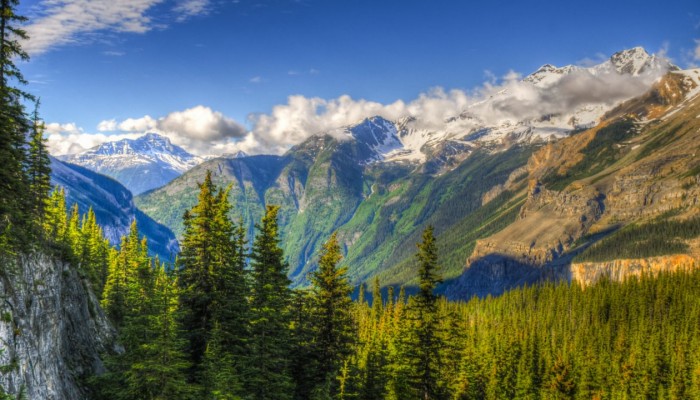
Geography of British Columbia
British Columbia is a rugged. Only 3% of its 364,764 square miles is classified as tillable, making 97% too wild to deal with! Mountain ranges, an extensive coast and insular region, and large swaths of preserved land off the beaten path mean that nature is always going to remain the supreme owner of BC.
The vast expanses contained by BCs borders do include striking diversity in ecological presentation. A rain forest, a desert, several unique mountainous zones, as well as intermediate areas of climatology exist as a framework for varied types of life. Plants and animals flourish in British Columbia. Humans are the newcomers to this Canadian province.
Situated on the western edge of Canada, British Columbia remained isolated from the western world for hundreds of years. Only one major metropolitan area, Vancouver, has affected the landscape beyond ancient recognitions. Innumerous possibilities exist to explore nature's offerings from sea level to some of the highest peaks Canada has to offer!
Pacific Coast
Steep and wet, British Columbia's westernmost edge is a carved out structure with striking features. Islands and inlets number so many that the 600 mile stretch of land between the Washington state and Alaskan borders holds nearly 16,000 miles of coastline. The World Wildlife Fund defines the BC coastal region as Pacific temperate rain forest.
Vancouver Island, the Queen Charlotte Islands, and the Gulf Islands are but a few that make up the 40,000 insular outcroppings in the province of British Columbia. Mountains covered by lush greenery dominate the islands. Bear, deer, insects, and a plethora of animals in between call these islands home. Whales and nearly countless varieties of marine life live in the waters that touch their shores.
Fjords line the mainland coast. It would take nearly a lifetime to explore all of the ins and outs of these craggy waterways that rise directly out of the depths into the Coast Mountains. Evergreen forests are thick here as precipitation coming from offshore storms dumps its payload along meeting the resistance of this range. A few of British Columbia's fjords work themselves into river inlets, aiding in the dominant returns of salmon to the region.
Just a few miles inland, mountain peaks rise above the forests. Mount Waddington is the highest in British Columbia at 13,186 feet of elevation; it lies across Vancouver Island's northern coast, near Knight Inlet. Weather in its surrounding Waddington Range is especially unpredictable, featuring some of the highest precipitation levels in BC.
Snow and glaciers are the dominant features at high elevations in the Coast Mountains. Along with the Monarch and Ha-Iltzuk icefields, the Franklin, Parallel, Scimitar, and other glaciers rest in the peaks. Very few places around the world allow a person to experience the majesty of the ocean and the power of alpine elevations within such close proximity to each other!
Mountains and Valleys
Inland British Columbia is a mixture of various mountain ranges connecting an expanse of wilderness nearly unrivaled around the world. The Rocky Mountains line the eastern edge of BC with high peaks. Mount Robson, elevation of 12,972 feet, is the highest point in the Canadian Rockies. Just west of this range is the Rocky Mountain Trench, out of which the headwaters of the Columbia and Fraser Rivers flow.
At extremely high elevation, evergreen forests of pine and fir give way to exposed rock and snow. Sub-alpine regions are dominated by grassy meadows. The steepness of these regions, often with minor plateau areas big enough to promote wildlife but not human proliferation, make for striking visuals. Big game animals can often be seen perusing above the tree line with snowy peaks in the background.
Most of British Columbia's rain falls in the Coast Mountains, but there is a wetbelt at the leading edge of the Rockies. Floral diversity is greater in this area than anywhere else in British Columbia. Hemlock, Cedar, Pine, and Fir trees are the tips of the proverbial iceberg here.
The Interior Plateau is a misleading name for the central region of BC. There is no flat expanse, but constant rolling hills and less extreme mountains than others. Lake and river gorges also exist through this vast expanse of bumpy ground. Northern reaches of the Interior Plateau are rimmed by the Interior Mountains. It is comprised of several named pieces that all describe the Interior Plateau as a whole: the Fraser Plateau, the Chilcotin Plateau, the Cariboo Plateau, the Bonaparte Plateau, the McGregor Plateau, the Thompson Plateau, and the Nechako Plateau.
South-central British Columbia is highlighted by the dry Okanogan Valley. Desert flora and fauna line the banks of several lakes that bisect the region. Winters are cold, but not frigid. Summers are very warm but not scorching. Low precipitation due to being on the protected side of the Cascade Mountains is the main reason for this semi arid landscape.
North British Columbia is mostly covered with the Interior Mountains. Icefields and glaciers feature heavily above the less dense forests than those of Southern BC. In the North East corner of the province lies a portion of the Yukon Plateau. Both of these regions are largely uninhabited.
Travel Essentials
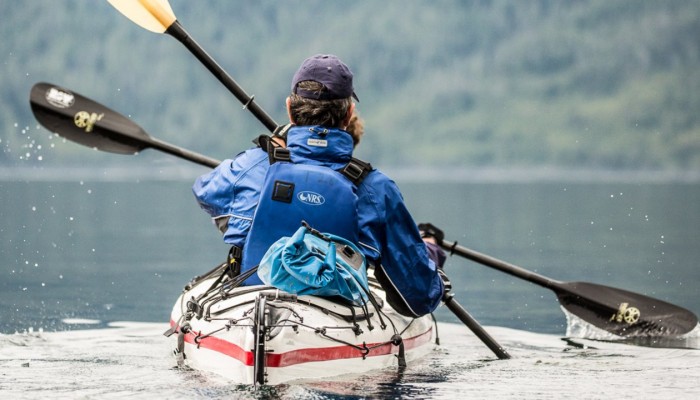
Money in British Columbia
British Columbia officially uses the Canadian Dollar. Another name people know for this is the loonie. A loonie is actually a one dollar coin. A two dollar coin is called a toonie.
Exchanging Money
Since the majority of the population center is so close to the United States, a high percentage of stores will exchange US dollars for Canadian dollars. Banks will offer a better exchange rate, though.
Credit Cards and ATMs
Credit Cards are generally accepted everywhere. Debit cards can be a bit more of a hassle. If a person does not have a Canadian bank issued debit card, it will generally not be accepted in most places, including ATMs. Traveler's checks are another option. They are generally accepted by bigger businesses.
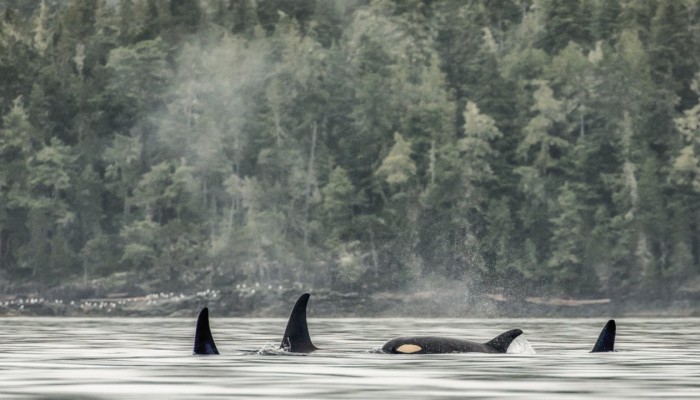
Health & Safety in British Columbia
Innoculations
Travelers do not require inoculations to visit British Columiba.
Travel Insurance
Taking out an insurance policy before traveling to BC protects against injury, illness, theft and loss. While a travel insurance policy may cover for loss of baggage, cancellations, tickets etc., many exclude activities listed as “dangerous sports” unless an additional premium is paid. Make sure to check the fine print.
In BC, these activities can include trekking, whitewater rafting and scuba-diving. Kayaking, however, is usually not considered a potential “dangerous sport.”
Make sure to keep receipts for medical treatment and/or medicines. Also obtain a statement from the police if you find yourself needing to make a claim.
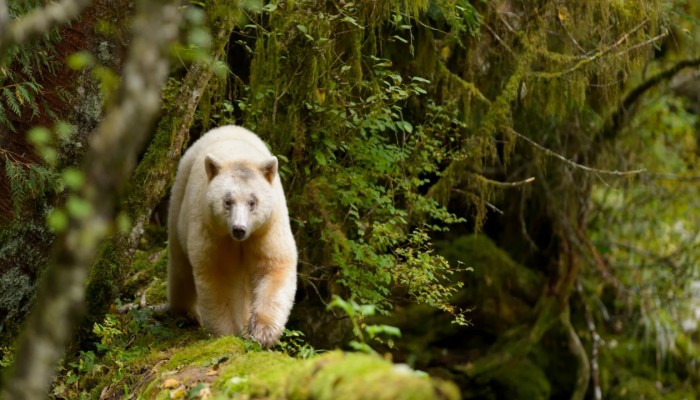
British Columbia Entry Requirements
Passports
Most international travelers require a passport to enter British Columbia. US citizens at land and sea borders have other options, such as an enhanced driver's license, permanent resident card or NEXUS card. Check out the Canada Border Services (www.cbsa-asfc.gc.ca) for approved identification documents.
VISAS
Visitors from certain countries require a visa to enter BC. Those who do not require a visa, with the exception of Americans, require an Electronic Travel Authorization. Travelers must apply for an ETA before traveling and can apply online.
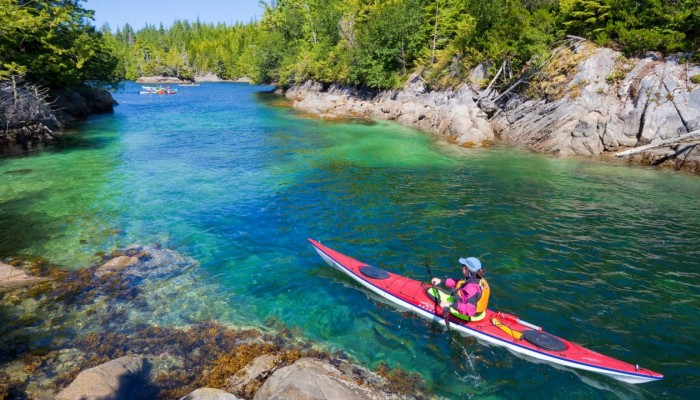
Internet & Phone Service in British Columbia
Phones
If you plan to use your mobile phone while in BC, be aware of and look into international data roaming charges as well as any likely call costs. It's also important to unlock your phone and ascertain if your phone is equipped for this frequency before travelling.
You may also look into kits equipped with a simple and prepaid SIM card.
Alternatively, if your phone is compatible and unlocked, it is possible to purchase a pay-as-you-go SIM card in BC.
Internet
Throughout the cities and even some rest stops, British Columbia has great internet overage. However, in BC's rural and wilderness areas, internet coverage is much more limited. Most hotels and lodges come equipped with internet access.
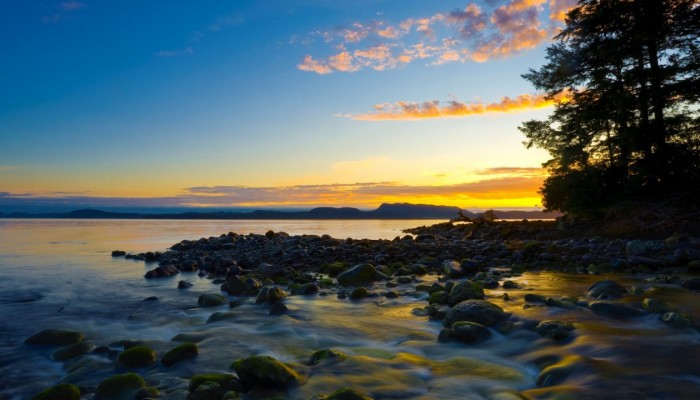
Power in British Columbia
Like the U.S., Canada uses 110-120V/60Hz. The primary socket types are the Type A and Type B styles.
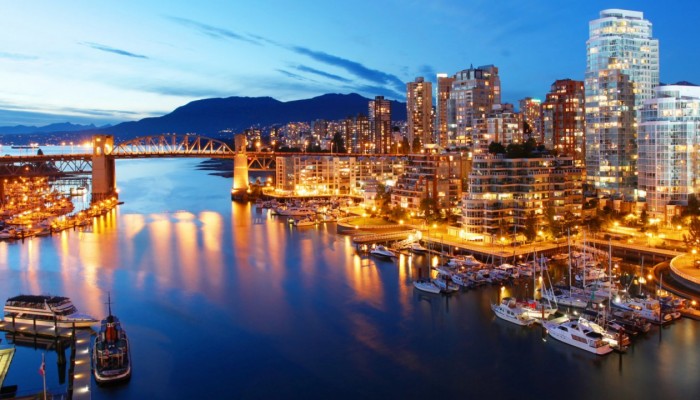
Getting to British Columbia
By Air
It's easy to fly into British Columbia:
- Vancouver International Airport and Abbotsford International Airport servicing the Vancouver area
- Victoria International Airport covering Vancouver Island
- Prince George Airport accessing BC's impressively vast northern terrain
- Kelowna International Airport accessing BC's interior
By Land
Driving remains a popular method of travel throughout BC. You can check out various routes through the helpful DriveBC website (www.drivebc.ca)
By Boat
You can explore BC by boat as well. BC Ferries operates the majority of BC's ferries, with main passages lying between Tsawwassen (south of Vancouver) and Vancouver Island's Swartz Bay as well between Tsawwassen and Nanaimo and Horseshoe Bay.
By Train
VIA Rail operates BC's primary train services, with rails stretching from Vancouver to Jasper and up to Prince George and Prince Rupert.
Related Blogs
Meet Our Guides
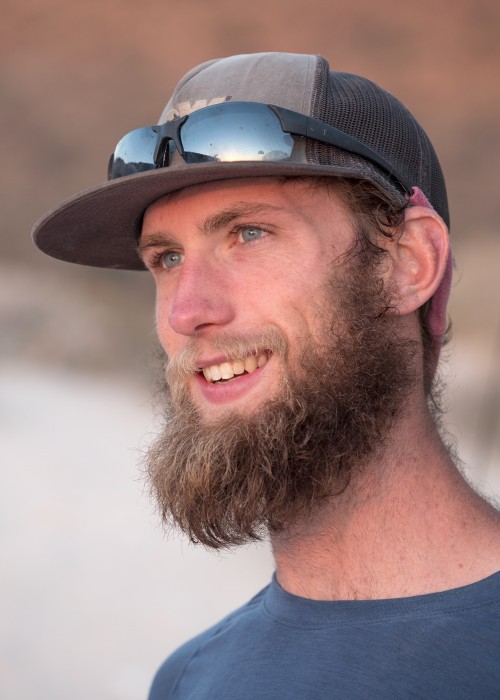
Colin Coon
British Columbia Sea Kayak Guide
Colin's love for the outdoors started as a boy. While growing up in Montreal, Quebec, Colin and his three brothers were always outside finding something to keep them busy. In 2011, Colin started guiding raft trips in Ontario and British Columbia. Over the last three years, while working on his B.S. in Physics from McMaster University in Ontario, Colin made a number of trips through Canada, the US, and Costa Rica. His love of the water, travel, and guiding landed him at ROW Sea Kayak Adventures in 2015. When this expert stone-skipper's not kayaking, you'll find him hiking, playing sports, and longboarding; oh, and possibly juggling! Maybe you'll get lucky on your next BC kayaking tour with us, and he'll put on a show!
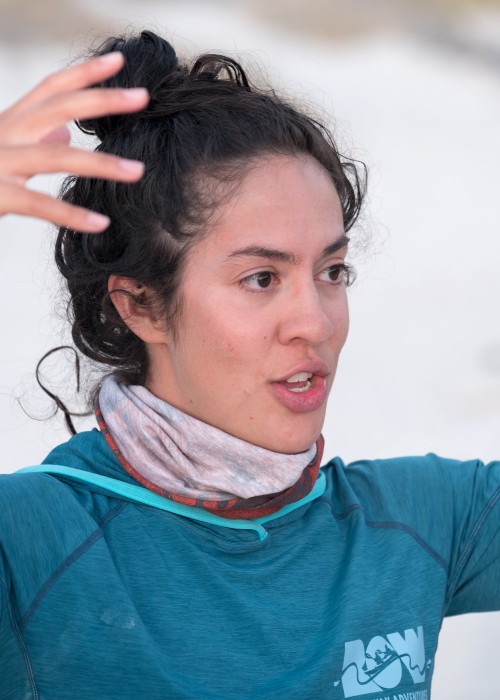
Daniella Rodriquez
British Columbia Sea Kayak Guide
Bio coming soon...
FAQ's
What immunizations are recommended or required?
The Center for Disease Control and Prevention (CDC) advises that travelers are up-to-date on their routine vaccinations before visiting Canada. This includes tetanus, hepatitis A, hepatitis B, diptheria, and typhoid, as well as measles, mumps, and rubella.
Can I drink the water in British Columbia?
It is generally safe to drink tap water in British Columbia, with the province having trustworthy water suppliers that are responsible for delivering safe drinking water to communities. Most restaurants in British Columbia have high hygiene standards when it comes to food preparation, so there shouldn’t be any issues eating raw vegetables, salads, or peeled fruit.
What type of Currency is used? Exchange Rate? Are US dollars accepted?
In British Columbia, the currency is the Canadian dollar, with $1USD equal to around $1.25CAD at the time of writing. Banknotes are available in $100, $50, $20, $10, and $5 denominations while the most frequently used coins are $2, $1, 25¢, 10¢, and 5¢.
Some businesses in British Columbia will accept US Dollars but they will set their own exchange rate, which may not always be favorable. Credit and debit cards are rapidly becoming the most popular means of payment at hotels, retail stores, and restaurants in the province’s urban areas, although some more remote places do still prefer cash. You can exchange foreign currencies at most banks, although most travelers just opt to withdraw Canadian dollars at ATMs. ATMs are widely available outside banks, in grocery and convenience stores, and at transportation stations. Banks are generally open from 9:00 to 17:00 Monday to Friday.
What time zone is British Columbia in?
Most of British Columbia operates on Pacific Standard Time (UTC -8) while the far southeast of the province follows Mountain Standard Time (UTC-7). Daylight savings time is observed from early March to early November across the province.
What is the official language of British Columbia?
While both English and French are official languages in Canada, English is the main language of communication in British Columbia. Tsilhqot’in, Dakelh, and Gitsenimx are the three most widely spoken Indigenous languages in the province while Cantonese, Mandarin, Punjabi, and Tagalog are also spoken by some residents.
Do I need a visa or passport to travel to British Columbia?
A passport with at least six months validity is required for entry into Canada and you should have at least two free pages for entry and exit stamps. Visas are not required to enter the country for citizens of most European countries, the United States, Canada, Australia, and New Zealand, although you will need to apply for an Electronic Travel Authorization if flying into or transiting through a Canadian airport.
Do I need Travel Insurance?
While it’s not mandatory to take out travel insurance to visit British Columbia, we highly recommend that you purchase a policy in case the unexpected happens. Look for a policy that covers in-country medical expenses, theft, and transportation delays while being sure to check if there are any activities or events that are excluded.
What is the best way to get around once I'm there?
WestJet and Air Canada Jazz both offer regional flights to destinations across British Columbia, with air travel sometimes more affordable than catching a bus or train. The Malahat passenger train runs daily between Victoria and Courtenay and is a particularly scenic way to explore the eastern shores of Vancouver Island. Efficient Greyhound buses link to major destinations across the province while a number of private bus companies travel between Victoria and Tofino on Vancouver Island.
BC Ferries operates an extensive network of car and passenger ferries along the coastline, many of which link mainland British Columbia to Vancouver Island. Port Hardy on the northern tip of Vancouver Island is linked by ferry to Prince Rupert on the northwest coast of the province.
Hiring a car will give you greater freedom to explore British Columbia and most of the highways are well-maintained and open year-round. Rental car agencies are easy to find in Vancouver and at Vancouver International Airport. Wearing seatbelts is compulsory in Canada and you must carry proof of insurance with you at all times.
When are the best times to visit British Columbia?
With its warming Pacific Ocean currents, British Columbia is one of the mildest provinces in Canada, particularly on and around Vancouver Island. Summer is one of the most popular times to visit when the temperatures are at their highest and North Americans are on their annual holidays.
To avoid the peak tourist season, you can visit during one of the shoulder seasons (April to early June or September/October), with the fall colors in British Columbia truly spectacular. November to March is ideal for snow enthusiasts wanting to go skiing at Whistler or for those in pursuit of the Northern Lights. June to October is generally considered the best time to see grizzly bears in British Columbia.
What kind of adapters will I need for my electronics?
Throughout British Columbia, electricity is supplied at 110 volts, with the same two-pronged flat plugs (Type A) that are used in the United States. In some cases, you will also find Type B power points that have two flat parallel pins and a grounding pin.
How much should I tip in British Columbia?
As in the United States, tipping is a standard practice throughout Canada, including in British Columbia. Restaurant waitstaff expect 15% to 20% of the bill while bar staff are usually tipped $1 per drink. At hotels, you can tip the porter $1 or $2 per bag and cleaners $2 a day. It’s customary to tip taxi drivers between 10% and 15% of the fare.
Is travel to British Columbia safe?
British Columbia is considered a safe place to visit, with petty crime only an issue in the big cities like Vancouver. That being said, it’s recommended that women, in particular, avoid hitchhiking in the province and you should always be vigilant about the presence of wild animals, such as bears and cougars.
If you’re visiting British Columbia in the winter, it’s important that you’re prepared for snowstorms, with snow chains required by vehicles driving along the province’s mountain passes. Self-drivers should ensure they have extra fuel, a First Aid kit, and a flashlight, as well as food in case you get stuck for an extended period.
If you are concerned about safety, we recommend traveling with a reputable tour company and check any current travel warnings issued by the U.S. Department of State prior to leaving home.
Are there cultural sensitivities I should be aware of?
Culturally, Canada is quite similar to the United States, with most people having a relaxed yet reserved frame of mind. It’s common to shake hands in greeting, although close friends will embrace or sometimes kiss one another on the cheek. Canada is a country of diverse cultures and beliefs, with most people open-minded about religious differences and sensitive to minority groups.
On Vancouver Island, there are three main First Nations groups - the Kwakwaka'wakw, the Nootka, and the Coastal Salish. Their way of life and spiritual culture is strongly linked to the natural world, which is visible in the beautifully carved totem poles and longhouses that dot the island. Learning about First Nations history and culture while being immersed in the breathtaking beauty of Northern Vancouver Island and Haida Gwaii is a special experience.
What is the food like? Any special dishes or local delicacies I should try?
British Columbia boasts a dynamic culinary scene that’s influenced by the various global communities that have made the province home. There’s an abundance of restaurants throughout the province that deliver farm-to-table experiences, drawing on organic produce and/or heirloom vegetable varieties. It’s not uncommon to see on menus exactly where the ingredients have been sourced from.
Coastal British Columbia is particularly renowned for its seafood, with king crabs, oysters, and shrimp often featuring on menus. If you’re visiting Vancouver, don’t miss the opportunity to try a BC Roll - sushi that’s filled with cucumber and barbecued salmon. The Chinook (king salmon) and Sockeye are among the most prized, with salmon fish ’n chips and salmon burgers dished up in restaurants and pubs throughout British Columbia. Other fish to look out for include rock and black cod, halibut, and tuna. The province has also garnered a reputation for its ranch-raised beef and lamb while buffalo and venison are gaining in popularity.
Fruits including apples, pears, peaches, apricots, and a variety of berries are grown in the province and appear in a multitude of forms. The Okanagan Valley is a particularly renowned fruit-growing region, as well as boasting around 120 wineries where both white and red wines are produced. British Columbia’s craft beer industry is also booming and you’ll find no shortage of unique options to satisfy your thirst.


